January started off with Hanshi Dometrich having a total knee replacement on his left leg. The operation took place at the Veterans Hospital in Cincinnati Ohio on January 4th. Hanshi was in the hospital for four days then allowed to
come home. He was up and around on crutches within a week.
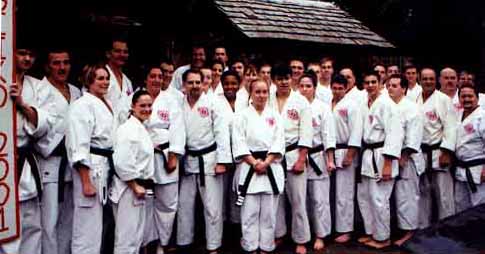 January 25th the 22nd annual Kangeiko was held at the Yoseikan Hombu dojo in Covington, Ky. The training was lead by Renshi James Davenport and assisted by Manuel Byers, Hanshi Dometrich came on his crutches at 6 am to observe some
of the intense training. After breakfast many students stayed on for the regular Saturday class and then in the afternoon attended Black Belt Class. It was a full weekend for many who had traveled from Pennsylvania, Indiana, New
York, Florida, Kentucky and Ohio.
January 25th the 22nd annual Kangeiko was held at the Yoseikan Hombu dojo in Covington, Ky. The training was lead by Renshi James Davenport and assisted by Manuel Byers, Hanshi Dometrich came on his crutches at 6 am to observe some
of the intense training. After breakfast many students stayed on for the regular Saturday class and then in the afternoon attended Black Belt Class. It was a full weekend for many who had traveled from Pennsylvania, Indiana, New
York, Florida, Kentucky and Ohio.
In February Hanshi and Okusan Dometrich flew to West Palm Beach Florida to attend Shihan James Matthews’ annual February seminar. Hanshi Tsuruoka and Hanshi Dometrich taught the seminar Hanshi was just starting to walk without
his crutches but managed very nicely. Several students along with Renshi Hawkins, from the Yoseikan II dojo in Cincinnati, Ohio, attended. Sensei Fleetwood from Savannah Ga. along with students from Shihan Art Rott’s dojo in
Orlando also attended the seminar. Afterwards Shihan Matthews’ students hosted a potluck dinner.
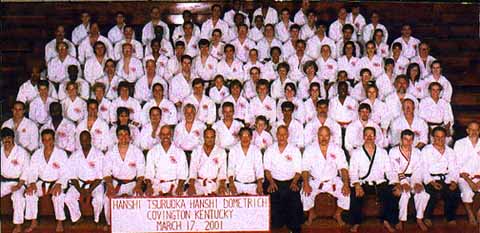
March 14/15th The U.S. Chito-kai held its annual Spring Black Belt testing, Seminar and Banquet. The seminar was held at the Ludlow High School gym, with Hanshi Tsuruoka as guest instructor along with and Hanshi Dometrich and
several senior instructors from The U.S. Chito-kai. After the Seminar a Banquet was held at a local seafood restaurant; Hanshi made the announcement of who had passed the test that was given earlier in the day. It was also
Hanshi Dometrich's Birthday.
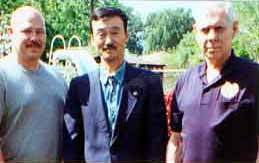 April 11/12/13 thirteen members of the United States Chito-kai had purchased airline tickets to attend the Ozawa Memorial Karate championships. The tickets had already been bought when we found out that the Tournament had been
canceled, so our group went anyway and made a mini vacation out of it. We got to see Las Vegas since we hadn't before because all our time had always been spent at the tournament and seminars. Some of us went to Boulder Dam and Red
Rock Canyon. Hanshi and Okusan along with Renshi Davenport and his wife Laura drove to San Bernardino Calif. to visit with Yukinori Kugimiya and his mother.
April 11/12/13 thirteen members of the United States Chito-kai had purchased airline tickets to attend the Ozawa Memorial Karate championships. The tickets had already been bought when we found out that the Tournament had been
canceled, so our group went anyway and made a mini vacation out of it. We got to see Las Vegas since we hadn't before because all our time had always been spent at the tournament and seminars. Some of us went to Boulder Dam and Red
Rock Canyon. Hanshi and Okusan along with Renshi Davenport and his wife Laura drove to San Bernardino Calif. to visit with Yukinori Kugimiya and his mother.
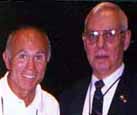 June 12-14,2001 the Police and Fire games were held in Indianapolis Indiana, Sensei Fumio Demura was the chief referee for the karate events. He asked Hanshi Dometrich to assist him. Hanshi's roommate was long time friend Bill
Wallace. Renshi Beshears came to assist with the matches. Not only did they have Martial Arts they had every kind of sport imaginable. The International Police and Fire games are held every three years, the next one will be held in
Barcelona Spain, 2003.
June 12-14,2001 the Police and Fire games were held in Indianapolis Indiana, Sensei Fumio Demura was the chief referee for the karate events. He asked Hanshi Dometrich to assist him. Hanshi's roommate was long time friend Bill
Wallace. Renshi Beshears came to assist with the matches. Not only did they have Martial Arts they had every kind of sport imaginable. The International Police and Fire games are held every three years, the next one will be held in
Barcelona Spain, 2003.
June 23rd Kyoshi Ken Tallack, Dai Nippon Butokukai Canadian representative, hosted a DNBK seminar in Toronto, Canada. Several members from the Midwest DNBK attended and demonstrated Chito-ryu.
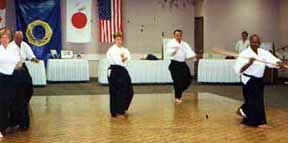
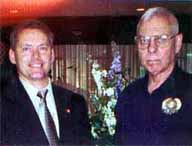
 June 26-30, 2001 the AAU (Amateur Athletic Union) held their National Karate Championships in Kenner, Louisiana. A small but dedicated group of karate-ka from the Yoseikan Hombu, who had first qualified at the
Kentucky AAU Tournament then at the region 6 Tournament in Chicago, made the trip. While there were only six students competing, they represented Chito-ryu and the Yoseikan Karate school exceptionally well. All six medalled and
qualified as AAU Champions.
June 26-30, 2001 the AAU (Amateur Athletic Union) held their National Karate Championships in Kenner, Louisiana. A small but dedicated group of karate-ka from the Yoseikan Hombu, who had first qualified at the
Kentucky AAU Tournament then at the region 6 Tournament in Chicago, made the trip. While there were only six students competing, they represented Chito-ryu and the Yoseikan Karate school exceptionally well. All six medalled and
qualified as AAU Champions.
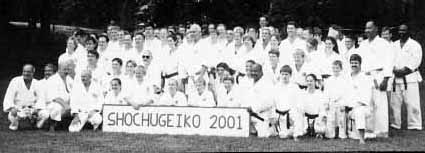 July 21,2001, Shochugeiko was held at Big Bone State Park. Students from all across the country attended. Senior ranking instructors of the U.S Chito-kai led group sessions. The event ended with a cookout.
July 21,2001, Shochugeiko was held at Big Bone State Park. Students from all across the country attended. Senior ranking instructors of the U.S Chito-kai led group sessions. The event ended with a cookout.
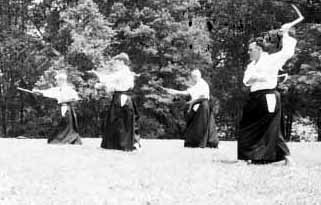

 The United States Chito-Kai would like to welcome Sensei Richey Brock from Birmingham Alabama into the United States Chito-Kai family. Sensei Brock has been a member of the Yoshukai organization, which is an offshoot
of Dr. Chitose's Chito-ryu.
The United States Chito-Kai would like to welcome Sensei Richey Brock from Birmingham Alabama into the United States Chito-Kai family. Sensei Brock has been a member of the Yoshukai organization, which is an offshoot
of Dr. Chitose's Chito-ryu.

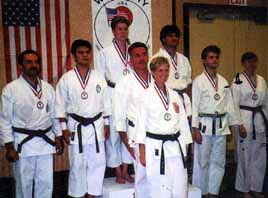
August 2001. Members of the Yoseikan Hombu attended the Annual Windy City Karate championships in Chicago, Ill. Joe Ganzalez, Shotokan stylist, hosts this tournament. Upon arrival in Chicago a number of the students went on a tour of
downtown Chicago to the Sears Tower, so they could say they had seen Chicago. Many students placed in the different divisions. The most memorable was the Kata Team; Connie Kramer, Sherry Kembre and John Wellbrock, winning over the
Detroit Team. The team won with the Kata Sochin. After the tournament our group ended up at an Italian restaurant. Before we left town we made a trip to the Japanese mall where we ate sushi and shopped. Then we couldn't leave
Chicago without one more visit to the Hard Rock Cafe on Michigan Ave.
August 2001, Kyoshi George Van Home, Kyoshi Jim Davenport along with Dr. Roy Moser and his son Rory attended the 2001 Okinawan Rengokai held in Atlanta Ga. Hosted by Dan Smith, vice president of the International Okinawan Shorin-ryu
Seibukan Karate-Do.
Sensei Miki and Yukiyoshi Marutani gave a fall seminar in West Chester Ohio. Sensei Miki, 8th Dan in Shito-Ryu, makes his home in San Diego California. Sensei Miki taught the Shito-Ryu kata Ni Pai Po. Several students from the Hombu
attended. Hanshi and Okusan were in attendance to observe. Sensei Marutani taught a session on Kumite. Our thanks to Mr. Quinn for the invitation and to Sensei Miki and Marutani for a very enjoyable workout.
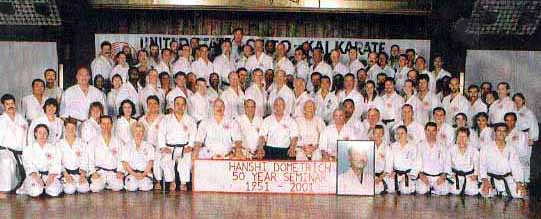
October 27th the United States Chito-kai held its annual Black Belt testing, Seminars and 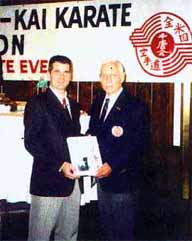 Banquet. This year was very special because we were celebrating Hanshi William Dometrich’s 50 years in Martial Arts. There
were 190 Instructors and students attending the seminars. Guest Instructors were Sensei David Akutagawa from Canada, Yukinori Kugimiya from California and Ken Sakamoto from Kumamoto, Japan. 254 members, friends and spouses attend
the Banquet. Many gifts, speeches and letters of respectful admiration were read. The whole weekend was very memorable for our Chito-ryu family. The highlight of the whole affair was when Hanshi was presented with the first
copy of his book "The Endless Quest" which he had been working on writing for two decades. Chris Johnston from Mississauga, Canada, who operates "Shindokan Publishers" and Okusan collaborated and led Hanshi to
believe that the book was going to be published in March 2002. Hanshi was really caught off guard when the book was presented to him. The book is now in its second printing.
Banquet. This year was very special because we were celebrating Hanshi William Dometrich’s 50 years in Martial Arts. There
were 190 Instructors and students attending the seminars. Guest Instructors were Sensei David Akutagawa from Canada, Yukinori Kugimiya from California and Ken Sakamoto from Kumamoto, Japan. 254 members, friends and spouses attend
the Banquet. Many gifts, speeches and letters of respectful admiration were read. The whole weekend was very memorable for our Chito-ryu family. The highlight of the whole affair was when Hanshi was presented with the first
copy of his book "The Endless Quest" which he had been working on writing for two decades. Chris Johnston from Mississauga, Canada, who operates "Shindokan Publishers" and Okusan collaborated and led Hanshi to
believe that the book was going to be published in March 2002. Hanshi was really caught off guard when the book was presented to him. The book is now in its second printing.
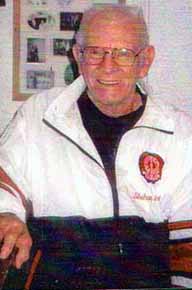
On a sad note: The Chito-ryu family lost its oldest student on November 17th, Shihan Art Rott. Shihan Rott was the head Instructor of the Orlando Fl. Yoseikan. Shihan attended the October banquet even though he was in poor health. He
gave a very moving speech with tears in his eyes. Shihan Rott was 83 years young. Several students accompanied Hanshi Dometrich and Okusan to Florida to attend his memorial service. Shihan is greatly missed.
 November 13,2001 The Mayor of Covington, Ky, Butch Callery, and the board of commissioners, commended William J. Dometrich on his 50 years of Martial Arts training and 22 years as a Police Officer in the city of
Covington Ky. (Hanshi retired at the rank of Lieutenant Colonel and the Assistant Chief of Police, in 1986.) Mayor Callery presented Hanshi Dometrich with the Key to the city. Two students of Hanshi Dometrich, Tom Schonecker and
James Liles were encouraged by Hanshi Dometrich to become Police Officers, these two men are now: Chief of Police (Tom Schonecker) and Assistant Chief of Police (James Liles) both men held Black Belts in Chito- Ryu.
November 13,2001 The Mayor of Covington, Ky, Butch Callery, and the board of commissioners, commended William J. Dometrich on his 50 years of Martial Arts training and 22 years as a Police Officer in the city of
Covington Ky. (Hanshi retired at the rank of Lieutenant Colonel and the Assistant Chief of Police, in 1986.) Mayor Callery presented Hanshi Dometrich with the Key to the city. Two students of Hanshi Dometrich, Tom Schonecker and
James Liles were encouraged by Hanshi Dometrich to become Police Officers, these two men are now: Chief of Police (Tom Schonecker) and Assistant Chief of Police (James Liles) both men held Black Belts in Chito- Ryu.
 |
The annual Kangeiko was held January 25, 2002. Taught by Kyoshi Davenport who was assisted by Bill Jansak (Yoseikan II, Cincinnati Ohio.) For those who have experienced Kangeiko there
are actually no words to describe it. For those who have not had the experience: SIGN UP! You will ask yourself, “What am I doing here? Why am I doing this?" After the reward of a cup of green tea at the end of
this unique workout, you will know for yourself what it’s all about.
|
| February 16, Shihan James Matthews held his annual seminar in West Palm Beach, Florida. Hanshi Tsuruoka and Hanshi Dometrich were the invited guest instructors.
At 7 am the students assembled on the beach for training. After breakfast Hanshi Tsuruoka worked with some of the students at the beach before the actual seminar, which was held in a
local recreation center. After the seminar the West Palm Beach karate club had a potluck dinner for all those in attendance. That evening we all met, and went to a Chinese buffet for a wonderful meal of sushi and seafood.
Students came from the Hombu in Kentucky and Kyoshi Hawkins attended with some of his students from Yoseikan II in Ohio, the Tampa and Orlando Chito-ryu dojos were in attendance as well as Michael Fleetwood from Savannah GA
|
 |
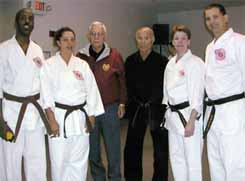 |
February 24, 2002 "Superfoot" Bill Wallace taught a seminar at NKU. He was sponsored by Sonny Barker of Barker's Karate School, Highland Heights Kentucky. Members in attendance from the Hombu were Sherry Kembre, Dan Schmidt, Eva Dupuis-Nouille. Leamon Collier from Yoseikan II Cincinnati Ohio was also in attendance. Sensei Wallace taught a very nice class on stretching and kicking (of course that’s what he does best). After the seminar Hanshi and Okusan attended a dinner for Sensei Wallace, later that evening they met with several members of the Hombu, and Yoseikan II, along with Kyoshi Davenport, at the Aronoff Center in Cincinnati, OH to attend a concert by the Shaolin Monks. It was a very entertaining evening.
|
March 3, 2002 - The Ohio AAU State Karate tournament was held in Cincinnati Ohio by Sensei K.Nishiyama, the state representative for the AAU. Several Chito-kai members from the Hombu dojo and the Yoseikan II, Cincinnati Ohio placed and went on to the regionals. Jerry Wellbrock and Don Schmidt helped with the refereeing and judging as they are certified with the AAU. Several other Chito-ryu members were able to assist during the day.
March 16, 2002 - Ik-kyu and Black Belt testing was held at the Yoseikan Hombu. Seven students tested for the rank of Ik-kyu through San-dan; Seven students failed. A seminar was held immediately following the test at Northern Kentucky
University. Instructors were Hanshi Dometrich, Kyoshi Davenport, and Renshi Byers. After the seminar a banquet was held att a local Chinese restaurant to celebrate Hanshi's 67th birthday.
| March 29 through April 4,2002 - Hanshi and Okusan accompanied their daughter Sherry Kembre and her children, Kira and Dylan, along with her mother-in-law Edith Edwards, to attend the National Teacher's Conference held by the Catholic Archdiocese. Sherry had already had Teacher of the Year bestowed on her by her district in Ohio and was now to receive the National Teacher of the Year award. While there, Hanshi explored the area, found the local karate school, and managed to help teach a class. We were able to spend some time exploring the famous Boardwalk.
|
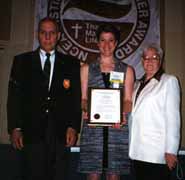 |
April 20-21, 2002 - Hanshi and Okusan, Jerry Wellbrock, Don Schmidt, Sherrry Kembre, Eric Ernest, Theresa Brandenburger, Eva Dupius-Nouille, Cheryl Widener and Laurie Apchin traveled to Chicago to compete in the AAU Regionals. This was only four days before Hanshi and Okusan were to accompany a group to the World Butokusai in Kyoto, Japan. Jerry, Don and Hanshi worked the two days refereeing and judging. Sherry, Theresa, Eva, Cheryl and Eric all qualified to go to the National Tournament to be held in Salt Lake City, Utah in July. 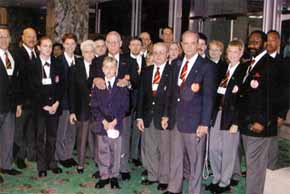
Kyoto Japan April 24-May 4, 2002 - Twenty- One members of the Midwest Division of the Dai Nippon Butokukai, with representative Hanshi William J. Dometrich traveled to Kyoto to attend the World Butokusai. Our group met up with the DNBK contingent from Virginia, in Detroit, Michigan to travel to Osaka Japan. There were over one hundred martial artists on the plane. Upon Arriving in Osaka, a bus was dispatched to take us to our destination of Kyoto. We spent one week there attending seminars, meetings, demonstrations and sightseeing. Twenty-one countries attended the Butokusai. Our group of twenty-one, along with Michael Colling from Nova Scotia Canada, spent the second week staying at the Osaka Hilton and exploring the castles, shopping arcades and sampling the foods. Some of us were even brave enough to venture on the train and travel back to Kyoto for some additional shopping.
| Sensei Inamoto arrived in Kentucky on May 4th to visit with Hanshi's daughter Devorah Herbst who is the official representative for Ryuku Kobudo in the United States. Sensei Inamoto had come to the U.S to accompany Devorah on a tour of the U.S and Canada teaching Kobudo. While here he visited the Yoseikan Hombu and helped teach a special class for Chito-ryu students along with Hanshi Dometrich
|
 |
May 9, 2002 Carl Robinson of Karate Fitness USA, in Florence, Kentucky hosted the Kentucky State AAU Tournament at the Drawbridge Inn in Ft. Mitchell Kentucky. Again, Jerry Wellbrock and Don Schmidt were there helping with the officiating, along with several other Yudansha of the Chito-kai organization. Hanshi Dometrich was on hand to help arbitrate and to sign his new autobiography “The Endless Quest", several members of the Yoseikan II and Kami Yama dojos and the Hombu qualified to compete in the AAU Regionals, which would be held in Chicago Ill. on April 20, 2002.
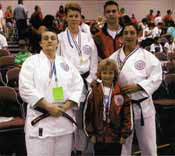 |
The AAU National Karate Championships were held in Salt Lake City,Utah July 1 - 6, 2002. Hanshi Dometrich, Okusan, Jerry Wellbrock, and Don Schmidt flew out as the advance party. Sherry Kembre her children Kira and Dylan, and Theresa Brandenburger flew out the next day. Eva and her son Keir had arrived a day earlier. Cheryl Widener was unable to attend due to back problems. Wes Ernest and his son Eric where already there when we arrived staying in a condo near the Olympic village. The tournament was five days long so most of every day was spent at the convention hall. Eva had rented a van and on our free time we had the opportunity to visit the Olympic Village (which was very impressive) we visited the Mormon church and the Salt Lake which I must say, wasn't a pleasant smell. Each evening we would take turns suggesting a different dinner restaurant, I think we tried them all! Eric was disqualified for knocking out his opponent. However Sherry Kembre went on to the finals and took third in kata and second in kumite in the black belt division Theresa Brandenburger took second in kumite and kata in the senior black belt division. Tori Griffith from Sensei Byers’ dojo in Cincinnati, Ohio, placed third in kumite in the brown belt division.
|
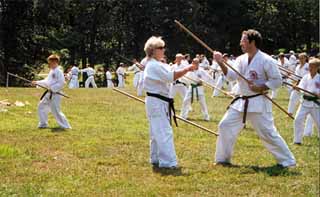
|
July 20, 2002 - The United States Chito-Kai held its annual summer training at Big Bone Park, Kentucky. Ninety-four students attended this year from Kentucky, Ohio, Maryland, Pennsylvania, Illinois, Florida, Georgia, and Puerto Rico. The training was taught by the senior black belts of the organization and a class of Kobudo was taught by Devorah Herbst. After the training, Kathy Webster and a few of the wives of members of the hombu had a cookout with plenty of good food for everyone.
|
|
July 2002 - the United States Chito-Kai re-established the Chito-ryu dojo in Puerto Rico, with Juan Rodriguez as the Instructor, Several years ago the U.S. Chito-Kai had a dojo under the leadership of Diego Cardin, this school didn't comply with the guidelines of the organization so they lost their charter. Juan Rodriguez has traveled to Kentucky on several occasions for training and senior students with Hanshi Dometrich have plans to visit Puerto Rico in 2003.
|

|
The end of July early August Hanshi and Okusan took a vacation and traveled to Montana to visit with Sensei Paul Menkhaus and his wife Claire. Hanshi and Paul trained in kata and time was spent sightseeing the Rocky Mountians. After leaving Montana we traveled to Colorado, and ended up in Branson, Missouri visiting with our friends Wayne and Susan Carmen, Wayne Carmen wrote a book entitled Elvis's Karate Legacy. Sensei Carmen was a friend and training partner of Elvis. Elvis Pressley held a sho-dan (first degree black belt in Chito-ryu). He studied with Hank Slemansky, a Chito-ryu stylist, while stationed in Germany with the U.S Military. Elvis was promoted to Sho-dan in 1960. O-Sensei Dr. Chitose confirmed this on his last trip to Kentucky in 1982. If you would be interested in this book, write to Legacy Entertainment Inc. 208 E. College St, suite 1. Branson Mo. 65616. or e-mail legacyentertament@tri-lakes.net.
|
September 12, 2002. The Yoseikan Students at the Hombu lost their dearest friend and den mother, as Hanshi always referred to Mrs. Ruth Roaden who lived next door to the Hombu dojo. Ruth was always there for whatever was needed. Ruth was 82 years old and was in failing health for the last couple of years. We already miss her being there for us.
|
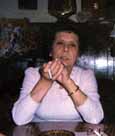
|
The 10th annual Windy City karate tournament hosted by Joe Gonzales in Chicago Illinois was held on September 14 and 15, 2002. Due to prior commitments there were not any students available to attend, as school had just begin and vacations were over. Hanshi and Okusan did attend to support Sensei Gonzales. Hanshi Dometrich was honored with an award for his support of the Windy City Tournament for the past 10 years.
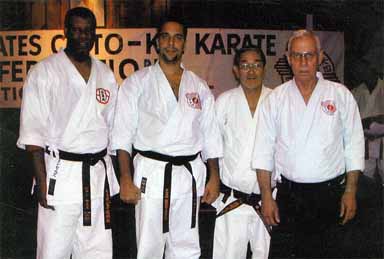
|

|
The United States Chito-Kai annual Black Belt testing, seminars and banquet was held on October 25- 26, 2002. All the events except for the testing, which was held at the Yoseikan Hombu in Covington, were held at the Drawbridge Inn and Convention Center in Ft. Mitchell, Kentucky. Guest instructors were Hanshi Masami Tsuruoka and Hanshi John Sells, author of the book Unante. Hanshi Dometrich was also one of the seminar instructors. Each instructor rotated to three different groups every hour for three hours. The groups were made up of black belts, green and brown belts, and white, yellow and orange. Total attendance was 194. Students had the opportunity to have Hanshi Sells and Hanshi Dometrich autograph books that were purchased at the seminar. Hanshi Sell's book “Unante: an in Depth History of the Martial Arts”, and Hanshi Dometrich's autobiography “The Endless Quest”. After the seminars the annual awards banquet was held, 207 students and friends attended. Results of the testing were announced, and certificates were awarded to those who had tested in the March 2002 test. Special awards were given to outstanding students and supporters of the US Chito-kai.

October 2002 US Chito-kai Testing, Seminars & Banquet
The US Chito-ryu Karate Federation held it's bi-annual Yudansha testing, seminars and banquet Saturday, October 26. We were fortunate to not only have Hanshi Dometrich in attendance, but Hanshi Masami Tsuruoka and
Hanshi John Sells as well. All three of these men conducted seminars during that phase of the events.
The day began early as those members testing gathered at the hombu dojo at 7:00am in preparation for the testing at 8:00am. There were 22 people testing for the ranks of Ik-kyu thru Go-dan. The test began with all
members completing a written exam covering the areas of Okinawan & Japanese karate history, technical information relating to karate in general and Chito-ryu specifically and medical information in relation to
injuries. Each members had already written an essay consisting of 500 words or more depending on the student's test rank. These essay are written on various topics ranging from Loyalty to your Sensei, Theory and
Counter Theory, The Importance of Understanding Martial Arts History, etc,.
Yon-dan & Go-dan testing was conducted first and three members would test for these ranks. Ik-Kyu, Sho-dan, Ni-dan & San-dan testing followed. The physical portion of the test consisted of basic waza, kata,
San-bon & Ippon kumite and Jiyu-kumite. The testing process lasted for approximately four hours. After the testing of 22 members, 14 members were advanced to the following ranks:
* Ik-kyu; Eva Dupuis Nouille, Roy Moser, Joe Campa, (All of the Hombu dojo), Gordan Levin (Orlando, Fl.), Jaclyn Krah, Julia Thaller & Brian Buirge (All of the Pittsburgh North dojo), Jackie Cross (West Virginia
dojo).
* Sho-dan; Taryn Cunba, Eric Ernest (Hombu dojo) Danielle James (Frankfort dojo), Leamon Collier (Yoseikan 2 Cincinnati, OH dojo), Latorria Griffith (Kama Yama dojo Woodlawn Ohio ).
* San-dan; Mike Messinger (West Virginia dojo)
After grading the final written exams we were very pleased that every student passed and most made in the upper 90's. This is a turn around since several students were failing in every rank when this portion of the
test was originally initiated. I can personally state (since I developed the test) that this is not easy. It was obvious that the students were listening to their teaches and were studying.
After the testing process everyone moved to the Draw Bridge Inn which was to be the seminar & banquet locations. There would be 160 students attending the three seminars. Seminar were divided by into three groups
consisting of group one; Yellow belt & Orange belts. Group two; Green Belts & Brown Belts. Group three; all Yudansha ranks. Each of the three main instructors taught a block of instruction to each group.
Hanshi Tsuruoka covered basic bio-mechanics during all of his seminars and included bunkai from Ni-Sei-Shi kata for the green & brown belts. It does not take but a few seconds to quickly realize that Tsuruoka
Sensei can greatly increase one's power and speed through his emphases on proper body connections. I have personally had the opportunity to train with him many times and to teach along side him in numerous seminars
and he still amazes me with the ease of his speed and power. I have seen many, many seasoned karate men half his age attempt to block his punch and not a single one has done it. Hanshi Tsuruoka has had two books
written about his methods of karate. The Spirit of Karate-Do Teaching of Masami Tsuruoka and Spirit of the Sensei A Study of Japanese Martial Arts. Both of these books were written by his student Mr. Andrew Bowerbank
of Canada.
Hanshi Sells taught several kata during his three seminars. These kata consisted of Arakaki Sochin and Kenshu which was developed by the founder of Shito-ryu, Sensei Kenwa Mabuni. He also covered Hakucho-dai. Sensei
Sells' method of teaching impressed everyone. He taught with authority, but no arrogance and he was very patient and understanding of those members less coordinated than himself and requiring a little more energy to
teach. There is no doubt that this is one of the reasons he is so well liked in the martial arts community. Sensei Sells is the author of a book entitled "Unante" which many have called the authority on
Okinawan & Japanese karate history.
Hanshi Dometrich covered basic and advanced Chito-ryu techniques as well as the kata Ni-Sei-Shi along with the bunkai for this kata as developed by Dr. Chitose himself. The techniques as taught by Dometrich Sensei
make maximum use of the principles of economy of motion and explosive action initiated by the use of hip vibration. Stance transitions were covered with emphases on the ability to explode from one posture to another
with maximum force. Rinten & Hanten Irimi applications were covered as well. When one observes the methods of applications as taught by Dometrich Sensei it is easy to see that these applications are above all
else, highly functional. This is not a surprise to anyone who knows that he served as a police officer for well over 20 years and had the misfortune or fortune (Depending on how one looks at it) of being in a
position to apply these techniques when someone is doing their best to escape or strike back. Hanshi Dometrich has also written a book entitled "The Endless Quest" This book relates the early studies of
Hanshi Dometrich when he first began his training in Japan over 50 years ago under the founder of Chito-ryu, Dr. Chitose.
We were fortunate to have Sensei Dan Smith of Seibukan stop by to join in the training. It was good to see him and share some time with him. He is a very knowledgeable karate Sensei and always easy to talk to. Both
Kyoshi VanHorne and I have visited him in his home many times and trained with him and his teacherHanshi Zempo Shimabukuro. He is a very special person who treats everyone well.
We were also fortunate to have in attendance Sensei James Morrone a Shoto-kan stylist from Detroit. Sensei Morrone has been a long time friend of Hanshi Dometrich for many years.
We were fortunate to have two of our Canadian brothers attending. Sensei Mike Colling and Mr. Chris Johnson. Sensei Colling runs a dojo in Nova Scotia. Mr. Johnson has recently translated a couple of book. One of
these translations is entitled "Kempo Karate Universal Art of Self-Defense". This book was the first book ever written by Dr. Chitose and was originally published in the early 1950's. The second book is
entitled "Aikido Shugyo Harmony in Confrontation" and was written by the Aikido Sensei Gozo Shioda of the Yoshin-kan style of Aikido.
After the seminars several schools gave demonstrations of their skill.
The evening ended with the banquet. There were 192 people in attendance. The banquet began with a very nice meal. Past rank advancements were acknowledged by the issuing of rank certificates. Several gifts were
exchanged. US Chito-kai annual awards of recognition were awarded for outstanding contribution to the organization:
* Shihan James Matthews (West Palm Beach, FL) - Nempai (Older brother/sister)
* Kathy Webster (Hombu Dojo) - (Sempai Big brother/sister)
* Shawna Lingo (Yoseikan II Cincinnati, OH) - Kohai (Younger brother/sister)
* Cyna Khalily (Yoseikan II Cincinnati, OH) - Chi (Wisdom)
* Johanna Willis (Hombu Dojo) - Gin (Benevolence)
* Eric Ernest (Hombu Dojo) - Yu (Valor)
* Shihan Barbara Tarzynski (West Virginia) - Annual Joe Petty Children Award
* Renshi Terry Valentino (Pittsburgh North) - Sensei of the Year
* Juan Rodruiguez (Puerto Rico) - newest school
* Laurie Apchin (France) - travelled farthest to the clinic
* Hombu Dojo Outstanding Awards: Renshi Jerry Beshears, Don Schmidt, Russell Banks
Several members were promoted and issued titles. Hanshi Dometrich awarded:
* Sensei Joe Hedderman the rank and title of 7th Dan, Kyoshi in Jujutsu as issued by the Dai Nippon Butokukai. Sensei Hedderman has studied Jujutsu for over 50 years and has remained a 4th Dan for well over 30
years after the death of his Jujutsu Sensei
* Kyoshi to Sensei Lawrence Hawkins, Jr.
* Renshi & 6th Dan to Sensei Terry Valentino
* Renshi to Sensei Jerry Wellbrock
* Renshi to Sensei Sherry Kembre
* Renshi to Sensei Manuel Byers
* Sensei Cyna Khalily was awarded the title Shihan.
Congratulations to all.
Sensei Nishime of Matsubayashi-ryu and a direct student of the founder Sensei Shoshin Nagamine was also present at the banquet and it was good to see him.
The complete event could not have happened without the guiding hands of Kyoshi Barbara Dometrich, Renshi Sherry Kembre and Kathy Webster. Thank you for a wonderful event.

|

|
November 2,2002 Hanshi and Okusan Dometrich, Kyoshi Davenport, and Renshi Michael Colling of Nova Scotia drove to Dothan, Georgia to pay respects to Mamoru Yamamoto, founder of the World Yoshukai organization. Sensei Yamamoto was a student of Dr.Tsuyoshi Chitose and left him in 1971 to found his own organization. Hanshi Dometrich and Yamamoto had not seen each for more then ten years. The Yoshukai organization hosted a Karate tournament in Dothan under the guidance of Mike Culbreth and Hiroaki Toyama.
December 16, 2002 - Hanshi and Okusan travelled to Pittsburgh, PA to attend a Christmas party hosted by the Yoseikan of Pittsburgh South Dojo. Hanshi Dometrich presented certificates to Kyoshi Hedderman, head instructor of the
Pittsburgh South Dojo, for Kyoshi and Shichi-dan in Jiu-jitsu. These certificates were awarded by the Dai Nippon Butokukai. Kyoshi Hedderman had travelled to Kyoto, Japan in April to demonstrate before the Hanshi Board at the World
Butoku Sai. The Christmas party was well attended by students, friends and family. A buffet dinner was served and the young people put on a Christmas pageant, singing several songs inspired and led by Susan Sbuscio. Santa Claus
(played by Stan Penkaala) was in attendance and gave the kids candy and gifts.
Kangeiko 2003
 Kangeiko 2003 was held January 24-25 at the US Chito-kai Hombu Dojo. Kangeiko is traditional cold weather martial training that is held during the coldest part of winter. This year’s event was well planned
as we had record cold temperatures in the Midwest the whole week as well as some light snow – perfect Kangeiko weather! In Japan, Kangeiko is usually help on a daily basis for an hour or two for anywhere from a week to a month.
The tradition in the US Chito-kai is a one day 6 hour session of intense “Spirit training”. This year marked the 24th consecutive year for Kangeiko at the Yoseikan Hombu. Following in tradition, the event begins the night
before, when all participants and instructors gather at the Hombu Dojo. An excellent pre-training meal of pasta and salad (also known to some as “the last supper”) was prepared by Okusan and Kathy Webster. Participants
sleep on the Dojo floor and although the forecast was for temperatures around zero overnight, there is no heat during Kangeiko. Prior to lights-out a pep talk was delivered by Kyoshi VanHorne and Kyoshi Davenport. Kyoshi Davenport
served as principal instructor for the event and has participated in 23 Kangeiko, most of which he has led. In attendance were 28 karate-ka from the Hombu, West Virginia, Pittsburgh, Frankfort, and Cincinnati. But the prize for
longest distance traveled for the event goes (once again) to Laurie Apchin from Provence, France (can anyone say “Road trip”?). Kyoshi Davenport was assisted by Kyoshi VanHorne and Renshi Valentino. Students ranged in rank
from green III (the minimum requirement) to Yon Dan, from 17 to 52 years old and from first timers to Sensei William Jansak from the Yoseikan II Cincinnati, a veteran of 20 consecutive Kangeiko.
Kangeiko 2003 was held January 24-25 at the US Chito-kai Hombu Dojo. Kangeiko is traditional cold weather martial training that is held during the coldest part of winter. This year’s event was well planned
as we had record cold temperatures in the Midwest the whole week as well as some light snow – perfect Kangeiko weather! In Japan, Kangeiko is usually help on a daily basis for an hour or two for anywhere from a week to a month.
The tradition in the US Chito-kai is a one day 6 hour session of intense “Spirit training”. This year marked the 24th consecutive year for Kangeiko at the Yoseikan Hombu. Following in tradition, the event begins the night
before, when all participants and instructors gather at the Hombu Dojo. An excellent pre-training meal of pasta and salad (also known to some as “the last supper”) was prepared by Okusan and Kathy Webster. Participants
sleep on the Dojo floor and although the forecast was for temperatures around zero overnight, there is no heat during Kangeiko. Prior to lights-out a pep talk was delivered by Kyoshi VanHorne and Kyoshi Davenport. Kyoshi Davenport
served as principal instructor for the event and has participated in 23 Kangeiko, most of which he has led. In attendance were 28 karate-ka from the Hombu, West Virginia, Pittsburgh, Frankfort, and Cincinnati. But the prize for
longest distance traveled for the event goes (once again) to Laurie Apchin from Provence, France (can anyone say “Road trip”?). Kyoshi Davenport was assisted by Kyoshi VanHorne and Renshi Valentino. Students ranged in rank
from green III (the minimum requirement) to Yon Dan, from 17 to 52 years old and from first timers to Sensei William Jansak from the Yoseikan II Cincinnati, a veteran of 20 consecutive Kangeiko.
A crack of wood at 2:45 am – get up, roll up bedding, bathroom, change into Gi – no talking. Seiza – how long? Who knows, the clocks are all unplugged and it is dark outside. And it is cold – that would not
last long. Warm-ups followed by hundreds of basic blocks punches and kicks. And push-ups. Funny how people forget how to count at 3 am. Welcome to Kangeiko. In the past Kangeiko has been just this side of torture, at times just that
side of torture. We have all heard the stories of “the first Kangeiko” or “1983 Kangeiko” and the like. How tough it used to be. These stories are not urban legends, we were there and it is true. Condensation
totally fogging up the mirrors and causing the ceiling tiles to “rain” in the Dojo are no exaggeration. Those were definitely memorable times and there is something to be said for that type of shugyo. And while the workout
is still challenging, the philosophy of the US Chito-kai regarding Kangeiko has changed somewhat over the years. We must continue to pursue our mission in all of our everyday training; to learn something about ourselves and
Chito-ryu. Hanshi Dometrich and Kyoshi Davenport have made a commitment and concerted effort to be sure that Kangeiko participants walk away (if they can still walk) with something more than sore muscles. To that end, this year we
were exposed to various elements and Bunkai of Chito-ryu kata. Six hours of uninterrupted training overseen by Kyoshi Davenport is rare and unique opportunity and the participants took full advantage by repeating certain segments
and techniques over and over and over again. We were also introduced to Wunsu and Ananko kata. Kyoshi Davenport explained that these are traditional Okinawan forms and that even though they are not part of the mainstream Chito-ryu
curriculum they were practiced and taught by Dr, Chitose. Kysohi Davenport and Renshi Valentino learned these kata from Katoh Sensei during his visit to the US. Again, since time constraints were not as imposing as regular class we
were able to repeat the kata many times to help with the memory. Kyoshi VanHorne taught his interpretation of NiSeiShi kata and Bunkai; a twist on our traditional KaiSetz. We worked stances, leg strength, hip snap, hip thrust, over
and over again. Then came time for the run – was it 6 hours already? – you never know, there is always the possibility that the run will be half-way through this year.

The run is through the streets of Covington in frosty weather and a nice layer of snow and ice covered the sidewalk. The site of 30 Karate-ka running in their gi always draws curious looks from the citizens at the bus stop,
while they appeared quite cold in full winter armor – down coat, hat, mittens, boots, some of us weren’t even wearing shoes! (numb feet don’t hurt by the way). Back at the Dojo after a few more Seiken cho Tsuki we
were congratulated by Kyoshi Davenport – indeed it was over and we had all done our best and everyone learned something new. A cup of green tea as a ceremonial end to the training and a toast to O-Sensei, Hanshi, the US troops,
and brotherhood. After bowing-out, participants were further rewarded by a breakfast feast of prodigious proportions prepared as usual by Okusan, Kathy Webster and the crack staff at the Hombu Dojo. But the day was far from over;
many of the participants stayed and participated in the 10 am class and Black Belt class. 3 am until 3 pm, now that is a day (literally) of Karate training!
Many thank-you’s to Hanshi and Okusan for organizing and hosting another successful event. Thanks to Kyoshi Davenport, Kyoshi VanHorne and Renshi Valentino for excellent instruction and motivation, and to all the
participants from far and near. This type of training and brotherhood is rare and everyone in the US Chito-kai would be well served to participate. I do not know of anyone who has regretted the decision to participate in Kangeiko.
Next year will be the Silver Anniversary – 25 years – and promises to be an event not to be missed. When you are a veteran of Kangeiko you are in elite company. Everyday class and everyday life are put in perspective.
See you in January 2004.
Cyna Khalily, MD
West Palm Beach 2003
What a great week to leave the white stuff in Cincinnati behind and say hello tot he white sandy beaches in West Palm Beach, Florida. Weather was perfect everyday – 75 – 80 degrees for highs which made Sensei Matthews’
clinic that much more enjoyable. Activities included karate, para-sailing, wave runner rentals, fishing, swimming, sun bathing and whatever one could think of to take advantage of weather we northerners seek in February. The only
bad thing that happened was that Hanshi and Kyoshi Dometrich blew a head-gasket in their camper and only got as far as Winter Garden Florida. Their absence was truly missed, but at least they were in warm climate making the most of
their situation.
Activities for the clinic kicked off on Friday night with a welcoming banquet at the hotel. Sensei Tsuruoka and Sensei Matthews hosted the event that was attended by 15 of the available participants in the clinic. Those present
included Sensei Davenport and his entourage of Karate-ka, a few Hombu karateka, and some West Palm karateka and guests.



On Saturday morning at 7 am, Sensei Tsuruoka led the “training on the beach”. Sensei Davenport, Sensei Hawkins, and Sensei Matthews assisted/participated and the following karateka were present: Ed Butzin, Daniel Davenport,
Evelyn Disher Hill, Tony DiTerlizzi, Kathy and Ron Emery, Wes Ernest, Kim Flossie, Carol Hayes, Brad and Warren Hill, Mark Lingo, Mina Ludwig, Al Maeyers, Joanne Martini, Darrin McCarthy, Alec McKenzie, Lisa Potter, Don Schmidt,
Michael Skaggs, Ed Vitek, Cliff Way, and Mike Wilson. Did anyone notice the sunrise or were you concentrating on your technique?
The Clinic began at 11 am and Sensei Tsuruoka, Sensei Davenport, and Sensei Hawkins taught the different groups. Sensei Daniel Davenport assisted Sensei Tsuruoka while Sensei Mina Ludwig assisted Sensei Hawkins and Sensei Alec
McKenzie assisted Sensei Davenport. As Sensei Davenport suggested we trained with our hearts on Hanshi and Kyoshi Dometrich’s situation.
The banquet on Saturday night was delicious and camaraderie was shared by all. The meal consisted of roast beef, chicken, at least 3 side dishes, a medley of desserts to choose and generous hospitality from the West Palm group.
Sensei Matthews’ clinic should be added to everyone’s list of “things to do”. Continued support of this clinic helps the organization as a whole and getting away from the north for a few days in February
certainly is something to look forward to. Now I need to go shovel my driveway which has a few inches of snow and ice on it.
By: Don Schmidt
US Chito-kai Hombu Dojo
Clarksburg, WV 2003
March 15, 2003 was the 68th birthday of Hanshi Dometrich. To coincide with this a special series of events was planed and implemented by the Bridgeport West Virginia Yoseikan. Clarksburg, WV rolled out the red carpet to honor one of
it’s favorite sons. What started out as a couple of small events blossomed into a full packed 3 day schedule.
Sensei Kevin Drummond and Sensei Michael Messenger along with Jackie Cross conceived and orchestrated the proceedings. The story actually began several days before the events were to begin in Clarksburg. Hanshi, Okusan and
Kyoshi Hawkins gave a telephone interview, which appeared in the March 12th issue of the Exponent Telegram, Sensei Drummond and Messenger also participated in the interview.
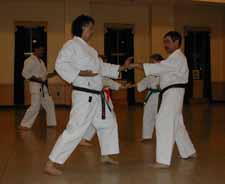 On Thursday morning, Hanshi, Okusan and others gave an interview and Karate demonstration for the local news, which aired on WBOY channel 12 on Monday March 17. Thursday evening Hanshi and Okusan attended class
at the Bridgeport Yoseikan. Also visiting were Renshi Jerry Wellbrock, Renshi Michael Colling, Shihan Cyna Khalily and Sensei Mina Ludwig. Linda Gage also came with a crew of kids from her school in Charlotte, VA. Hanshi Dometrich
led the class in Chito-ryu basics. For some of the students this was their first exposure to true “Chito-ryu” technique. But what an introduction – from Hanshi Dometrich himself! It was a great class.
On Thursday morning, Hanshi, Okusan and others gave an interview and Karate demonstration for the local news, which aired on WBOY channel 12 on Monday March 17. Thursday evening Hanshi and Okusan attended class
at the Bridgeport Yoseikan. Also visiting were Renshi Jerry Wellbrock, Renshi Michael Colling, Shihan Cyna Khalily and Sensei Mina Ludwig. Linda Gage also came with a crew of kids from her school in Charlotte, VA. Hanshi Dometrich
led the class in Chito-ryu basics. For some of the students this was their first exposure to true “Chito-ryu” technique. But what an introduction – from Hanshi Dometrich himself! It was a great class.
Friday’s schedule began with a trolley ride to downtown Clarksburg and “The Ordinary” restaurant for breakfast. We were joined by, Clarksburg Mayor Terry Greaver, Police Chief John Walker, County Commissioner Ron
Watson, along with Jim Hunt and Margaret Bailey of the Clarksburg City Council for a home cooked meal to start what would be an eventful day. Kathie Titus of the Clarksburg Visitors Bureau who helped coordinate many of the events
was also there for breakfast. Following this we boarded the trolley for the Federal Bureau of Investigation facility just outside of Clarksburg. Hanshi Dometrich is a graduate of the FBI national academy. Graduating from the FBI
national academy is an impressive accomplishment at any age, Hanshi Dometrich did it when he was 49 years old. This was not part of the original plan, but when local FBI officials learned that Hanshi was being honored they would not
be left out of the proceedings. The FBI facility is extremely high security, any potential visitors had the register in advance and security was tight. No cameras or other recording devices were allowed on the complex. This facility
houses among other things the FBI fingerprint library and is responsible for several hundred thousand fingerprint investigations a day. We were told that it is very rare that civilians are given a tour of the facility, and there
were 35 of us! But before the tour we had the “earn our lunch” so to speak. The tour started with a Chito-ryu demonstration of for some of the FBI employees. Many US Chito-kai karate-ka who had traveled to help honor
Hanshi participated in the demonstration. It is safe to say that all of the FBI audience was impressed. The ceremony honoring Hanshi at the FBI facility was hosted by assistant director Michael Kirkpatrick. After this there was book
signing by Hanshi and we were given a tour of the facility. At one point there was actually a fire drill and we were taken to the heart of the massive computer network for “safe keeping” until the all-clear was sounded.
Lisa Stout was the FBI tour coordinator.

From here we traveled to the Clarksburg city limits where we were joined by the mayor and other city officials for the dedication of the sign signifying Clarksburg as the Birthplace of Hanshi Dometrich. The sign reads “
Birthplace of Hanshi William J. Dometrich, founder of the US Chito-kai, Author of “The Endless Quest”, Official representative of DNBK, March 15, 1935”. The police stopped traffic on Buchannon Pike for the dedication
and photos. Hanshi pointed out that the house he was born in was actually just around the corner from the sign.
After this there was barely time to rest as we boarded the trolley back to the hotel and had enough time to change for dinner. Dinner has at Damon’s Grill in Bridgeport. There was a nice crowd gathered in a relaxed
atmosphere. No formalities at this event, just good food and good company. There was an incident with a waitress though, who apparently was able to get Renshi Valentino in a pretty mean rear-naked choke hold, “take that Judo
man” were here exact words. We are still not sure what he did to make her mad.
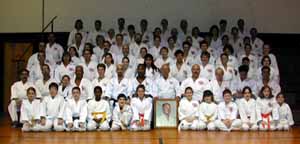
Friday started with a clinic in Bridgeport at 9 am. There were approximately 70 karate-ka present. Chito-ryu students from Clarksburg, Charlotte, Cincinnati, Pittsburgh, Frankfort, and West Palm were joined by several invited
local students from other styles. But the award for farthest distance traveled definitely goes to Renshi Colling from Nova Scotia Canada. The group was divided into smaller sections each led by a ranking Shihan or two, Hanshi
circulated between the groups to lend a hand and give advice when needed. It was a wonderful clinic and all the participants seemed to get a lot out of the instruction.
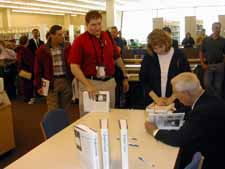
Following the clinic Hanshi and Okusan made a quick trip to the Bridgeport Library where they held a book signing and presented a signed copy of “The Endless Quest” to the library. After this, off to the Clarksburg library
for another book signing and presentation. At the Clarksburg library several students participated in a Chito-ryu demonstration and Shihan Herbst of RyuKyu Hozon Shinkokai Kobudo performed Chatan Yara no sai. Is it OK to kiai in a
library?

Friday night was the official birthday dinner and celebration for Hanshi held at Minards restaurant in Clarksburg. Surprisingly, the main course was spaghetti. In attendance were many Chito-ryu members and families. Also in attendance
were Mayor Greaver and FBI Director Steven Hook. There were many fine congratulatory speeches and gifts for Hanshi in honor of his birthday. Hanshi and Okusan were presented the keys to the City by Mayor Greavor. Kyoshi Hawkins
presented Mayor Greavor and the City of Clarksburg with a framed copy of the cover of Hanshi’s book. The evening ended with cake, song, good food and good friends.
All-in-all it was an eventful and exciting weekend. Sensei Drummond, Sensei Messenger, Jackie Cross and the Bridgeport Yoseikan should be proud.
From the US Chito-kai: thank-you to The Bridgeport Yoseikan, The City of Clarksburg and Bridgeport and everyone at the FBI facility for honoring Hanshi in such a fantastic way.
Cyna Khalily, MD
Chito-kai
2003 March National Clinic
On March 29, 2003 the US Chito-kai held it’s annual spring seminar and test. A National Test Board was convened on Saturday morning at the US Hombu Dojo for Ik Kyu through San Dan. The test was run very efficiently with no
wasted time. Passing the test were Diane Browne and Shawna Lingo from Yoseikan II in Cincinnati to Ik Kyu, Alan Renshaw and Michael Valentino from Pittsburgh Yoseikan North to Sho Dan (this was a double promotion for Mr. Valentino)
and Gregory Morris from Yoseikan II Cincinnati to Ni Dan. Congratulations to all testing. The next National Test Board will convene in October. Hanshi Dometrich has suggested that this may be the last March National Test Board.
After the test US Chito-kai President Kyoshi Lawrence C. Hawkins, Jr. read the revised and updated Constitution and By-Laws of the US Chito-kai to the members present. Afterwards the Shihan-kai met briefly.

National Test Board US Chito-kai Hombu Dojo March 2003
|
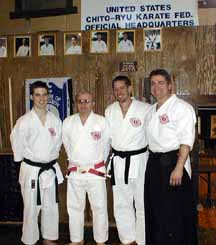
L to R: Michael Valentino, Kyoshi Hedderman, Al Renshaw, Renshi Valentino |
Following the test a clinic was held at Northern Kentucky University. The Guest instructor was Kyoshi Dan Smith assisted by Sensei Zenshun Shimabukuro. Kyoshi Smith is a direct student of Hanshi Zenpo Shimabukuro, son of Seibukan
Shorin-ryu founder Zenryo Shimabukuro. Kyoshi Smith is the Vice President of the International Seibukan Karate-do association and President of the US organization. Zenshun is Zenpo Shimabukuro’s son. Kyoshi Smith explained that
Shimabukuro Sensei developed the Seibukan style based on the teachings of Kyan Chotoku. Kyoshi Smith emphasized during the seminar “Speed above all else” as one of Kyan Sensei’s favorite precepts. Hanshi Dometrich
began the Seminar with a moment of silence for our Cincinnati Firefighter lost in the line of duty and for the US troops overseas and for the Iraqi people. Hanshi warmed the class up with Sanchin kata and then turned the class over
the Kyoshi Smith.
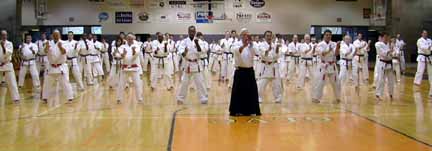 |
 |
The seminar specifically went over Wanchin kata. This is a kata that was developed by Zenryo Shimabukuro. Kyoshi Smith’s teaching style was really excellent. He established a relaxed atmosphere that was conducive to learning.
Even the lower rank belts in attendance were able to follow along. Kyoshi Smith explained that the way he teaches kata is how his Sensei taught, that is: to explain the movements of the kata in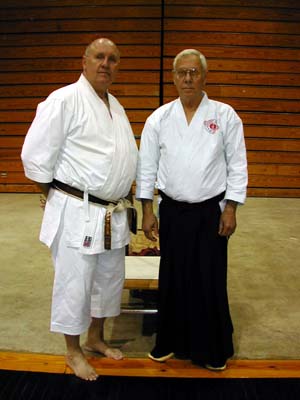 relation to their applications. That way the kata is learned in a context of individual technique applications. This did prove to be an effective teaching method, and even though many of the attendees may not
remember Wanchin kata exactly, they will at least have gained an understanding of the rational for some of the techniques contained therein. Kyoshi Smiths profound understanding of Karate history as well as his technical expertise
was evident during the coursed of the seminar. In addition to Wanchin kata, Kyoshi Smith also shared some insight into the meaning and application of “ippon kumite”. Three hours went by all to quickly. In the end, we found
that Seibukan Shorin-ryu and Chito-ryu are more similar than they are different. And we all agreed that continued brotherhood and exchange will make us all stronger. There were over 90 participants at the clinic from all around the
United States. This gym has a lot of history for the US Chito-kai – O-Sensei once taught a seminar there and many current members had their early lessons there. Thank-you to Dr. Willie Elliot for securing the venue and carrying
on the NKU Chito-ryu tradition.
relation to their applications. That way the kata is learned in a context of individual technique applications. This did prove to be an effective teaching method, and even though many of the attendees may not
remember Wanchin kata exactly, they will at least have gained an understanding of the rational for some of the techniques contained therein. Kyoshi Smiths profound understanding of Karate history as well as his technical expertise
was evident during the coursed of the seminar. In addition to Wanchin kata, Kyoshi Smith also shared some insight into the meaning and application of “ippon kumite”. Three hours went by all to quickly. In the end, we found
that Seibukan Shorin-ryu and Chito-ryu are more similar than they are different. And we all agreed that continued brotherhood and exchange will make us all stronger. There were over 90 participants at the clinic from all around the
United States. This gym has a lot of history for the US Chito-kai – O-Sensei once taught a seminar there and many current members had their early lessons there. Thank-you to Dr. Willie Elliot for securing the venue and carrying
on the NKU Chito-ryu tradition.
That evening there was a catered dinner at the Hombu Dojo hosted by Hanshi and Kyoshi (Okusan) Dometrich. Kyoshi Smith and Shimabukuro Sensei were guests of honor. US Chito-kai Vice-Chairman Jerry Wellbrock presented Hanshi with
several gifts for his birthday. Hanshi and Okusan also gave a special thanks to Sensei Kevin Drummond and Mike Messenger and Jackie Cross of the Bridgeport Yoseikan for hosting the special ceremonies honoring Hanshi on March 14-16.
Hanshi Dometrich, Kyoshi VanHorne and Davenport also gave special thanks to Kyoshi Smith and Sensei Shimabukuro.
Thanks as always to Kathy Webster and everyone else who helped with set-up and clean up at the Dojo, and to everyone who participated. It was a great event and great brotherhood.
Cyna Khalily, MD
US Chito-kai
2003 Shochugeiko
On July 19 2003 the US Chito-kai held it’s annual Shochugeiko outdoor Summer Training Seminar at Big Bone National State Park in Kentucky. There were over 90 attendees representing US Chito-kai schools from across the country.
The training ran from 11 am until 3 pm. Hanshi Dometrich assisted by senior Yudansha instructed different groups in a variety of Chito-ryu techniques ranging from Hojo Undo (supplementary training) to Gun Defense to Tegumi
(Grappling) to Tai Sabaki and Ashi Sabaki. Each group also had an hour of Kata training under the guidance of Hanshi and the Shihan-kai. It was a beautiful day – sunny and warm but not oppressively hot and humid like some years
past. Afterwards there was a picnic feast of prodigious proportions and plenty to drink. Thanks to everyone who helped with the meal preparation and clean-up. No fatalities, no casualties, and there was something for everyone to
learn and practice. We all enjoyed the brotherhood of meeting old friends and new in the great spirit of Budo and Chito-ryu. These events are always like a family reunion for the US Chito-kai and as much as we enjoy the camaraderie
and training, it is always over far to soon.
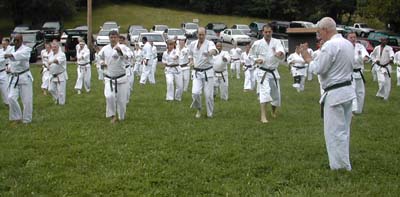
There are some significant upcoming events of the US Chito-kai that you may all want to be aware of. Labor Day weekend the Bridgeport West Virginia Yoseikan will host a summer camp at Audra State Park, WV. It has been over 10 years
since we last trained there and we hope to make it a triumphant return. Please contact Sensei Kevin Drummond or Sensei Mike Messenger for more information. The annual October Seminar and Banquet is around the corner. As in years
past it will be held at the Drawbridge Inn in Florence KY. Room reservations can be made now. In addition to Hanshi Dometrich, guest instructors this year include Hanshi Masami Tsuruoka, Sensei Doug Perry and Sensei Chuck Merriman.
Next years Kangeiko (Winter Training) in January will be the 25th Anniversary of the event.
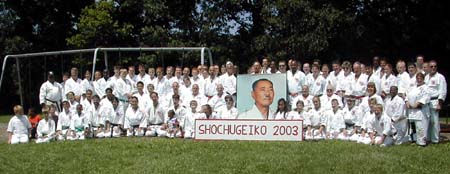
Cyna Khalily, MD
US Chito-kai
August 2003
I had the great pleasure of hosting my good friend and friend of the US Chito-kai, Sensei Yasushi Yamada of the Japan Chito-kai. Sensei Yamada is a Yon Dan and Head Instructor of the Tokyo Branch Dojo. He estimates the current
enrollment at his Dojo to be about 75 students; 40 children and 35 adults. I first met Yamada Sensei in 1989 at the Soke Cup in Vancouver, BC. Since that time I have visited him and his Dojo in Japan several times and he has visited
us here in the US, the last time being in 1996. The Kamidana over the entryway to the main deck at the Hombu was a gift from Yamada Sensei during his last visit. During his stay Yamada Sensei also visited Kyoshi Hawkins and the
Yoseikan II Dojo in Cincinnati. Yamada Sensei says that he feels a great respect for the US Chito-kai and it is always a great honor to visit Hanshi and Okusan and Kyoshi Hawkins. During his visit to the Hombu Yamada Sensei had the
opportunity to participate and teach in Saturday class. His Dojo emphasizes tournament style kumite, both light and full contact. As he explained, they always observe weight classes there so it was very interesting for him to
practice against much larger opponents than he is accustomed to. Yamada Sensei stressed footwork, an active rear leg, and paying particular attention to “keeping your guard up”. Most of us agree that he has great footwork
and very quick hands, particularly his jab. Likewise, he continues to be impressed with our power and kata skill. We had a great exchange of ideas and techniques. As always, we found that we have much more in common than different.
After the Kyu test we were treated to lunch at Pompillio’s by Hanshi and Okusan. Yamada Sensei was presented a gift of signed copies of “The Endless Quest” and “Karate Masters”. He has a long trip home, so
maybe he will get a good start on his reading! Yamada Sensei says it was a special honor for him to be able to spend time with Hanshi and Okusan in this manner.
It was a great visit, and another example of the brotherhood that is Karate-do. Yamada Sensei says he wishes to thank the US Chito-kai, especially Hanshi and Okusan and Kyoshi Hawkins for their great hospitality and friendship.
He asks that if anyone from the US Chito-kai visits Tokyo please feel free to contact him
Sincerely,
Cyna Khalily, MD

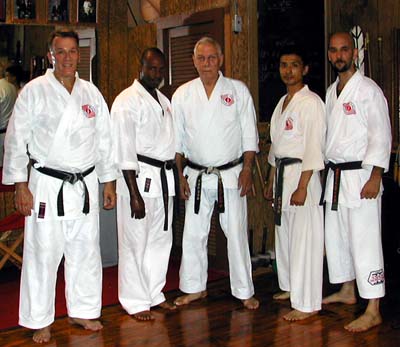
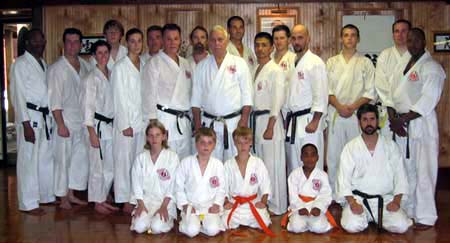
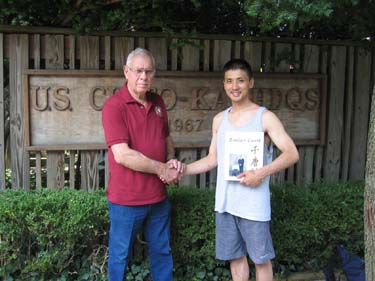

August 2003
Wednesday August 27th 2003 found Hanshi and Okusan Dometrich leading the way from Kentucky to Audra State Park in West Virginia for the Labor Day Weekend. Although leaving at different times 11 students and 7 more family members from
the hombu would spend the weekend camping on the Middle Fork River in Audra State Park. Chito-ryu students would also come from Cincinnati, Pittsburgh, West Palm Beach, Puerto Rico and of course the Bridgeport Yoseikan, our hosts
for the weekend who sponsored the Chito-Ryu Karate Clinic on Saturday and a weekend of great camping.
Karate-ka would be arriving throughout the day and night on Thursday and Friday and those who arrived in time enjoyed a wonderful Italian dinner prepared by Jackie Cross and her helpers from the Bridgeport Yoseikan on Friday
evening.
 Our training included a four-hour clinic on Saturday in heavy rainfall, which did not dampen our spirit but only afforded us the opportunity for a unique training experience in a much different
environment than the usual dojo or gym. Sensei Joe Hedderman commented before that clinic that we had never been rained out in over 30 years. Well we were not rained out only rained on and everyone actually enjoyed the training all
that much more. The different sessions included Chito-ryu basics taught by Hanshi Dometrich. Chito-ryu kata taught by Sensei Hawkins, Sensei Wilhelm and Sensei Kimbre. Jujitsu, which covered knife defense and ground fighting was
taught by Sensei Joe Hedderman, Sensei Tony Hedderman and Sensei Valentino. The last session was on kumite and was taught by Sensei Messinger and covered observation and analysis of your opponent’s fighting posture or kamae and
what to learn from it. Several students not wanting to stop the great day of training where last seen performing kata waist deep in the river after the clinic had formally ended.
Our training included a four-hour clinic on Saturday in heavy rainfall, which did not dampen our spirit but only afforded us the opportunity for a unique training experience in a much different
environment than the usual dojo or gym. Sensei Joe Hedderman commented before that clinic that we had never been rained out in over 30 years. Well we were not rained out only rained on and everyone actually enjoyed the training all
that much more. The different sessions included Chito-ryu basics taught by Hanshi Dometrich. Chito-ryu kata taught by Sensei Hawkins, Sensei Wilhelm and Sensei Kimbre. Jujitsu, which covered knife defense and ground fighting was
taught by Sensei Joe Hedderman, Sensei Tony Hedderman and Sensei Valentino. The last session was on kumite and was taught by Sensei Messinger and covered observation and analysis of your opponent’s fighting posture or kamae and
what to learn from it. Several students not wanting to stop the great day of training where last seen performing kata waist deep in the river after the clinic had formally ended.
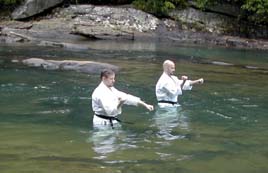
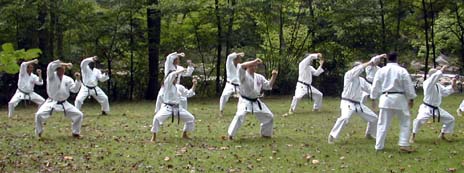
After the clinic there was a cookout at the home of Sensei Messenger’s uncle hosted by Senseis Messinger and Drummond and the Bridgeport Yoseikan. There was plenty of great food and live entertainment until late in the
evening. After the cookout the students from Cincinnati and Pittsburgh returned to the luxurious home and cabin graciously arranged for by Jackie Cross and her family. The hardcore campers from the hombu returned to Audra State Park
campground to enjoy a peaceful evening listening to the sounds of the tree frogs and the rushing waters of the Middle Fork River.

Sunday morning found most everyone headed for home except Sensei Kembre and Sensei Schmidt from the hombu who just had to have one more day of enjoying Audra State Park and the company of Sensei Messinger.
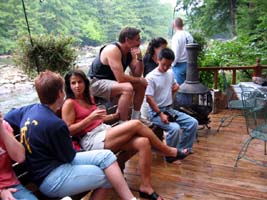

A special thanks goes to Hanshi Dometrich and all the Senseis who taught at one of our best clinics. Also a very special thanks to Sensei Michael Messinger, Sensei Kevin Drummond and his wife Cindy and to Jackie Cross and the
remaining students of the Bridgeport Yoseikan for putting together such a great weekend of karate and camping that allowed all of us to grow in our karate knowledge and more important to grow in our friendship. We are a karate
family.
Submitted. Sensei Jerry Wellbrock.
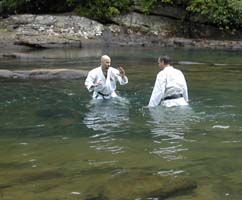
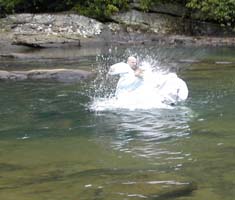
October 2003
The 2003 U.S.Chito-kai annual fall event was held in Northern Kentucky on October 24th and 25th. This year we celebrated the 105th anniversary of the birth of O-Sensei Tsuyoshi Chitose. Over 150 karate-ka participated in the testing
and clinic. The weekend’s events started on Friday night at the Hombu Dojo with a National Test Board for Yon Dan and Go Dan. To test for Yon Dan or Go Dan one must be nominated by the Shihan-kai and invited by Hanshi
Dometrich. Even so, half of those testing this year were retests. The test started at 7 pm with a written exam and did not conclude until after 10 pm. The National Test Board convened again the following morning at 8 am for Ik Kyu
through San Dan testing.
The Clinic started at 1 pm at the Drawbridge Inn and concluded at 4:30 pm. In addition to Hanshi Dometrich, invited guest instructors this year were Hanshi Masami Tsuruoka, Kyoshi Doug Perry (Shorin ryu) and Kyoshi Chuck Merriman
(Goju ryu). Of course, we all know Hanshi Tsuruoka! Kyoshi Merriman and Kyoshi Perry are senior ranking members of their organization in the U.S. and the world and are active members of the AAU. Hanshi Dometrich started the clinic
with a few basic Chito-ryu drills for warm-up and then turned the class over to the guest instructors. Each delivered a unique perspective on Karate training and even though our styles are different, the lessons were universally
applicable. From White Belt to senior Black Belt there was something for everyone.
|
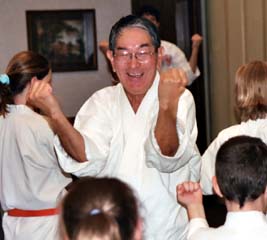
Hanshi Tsuruoka enjoys his work with the kids! |
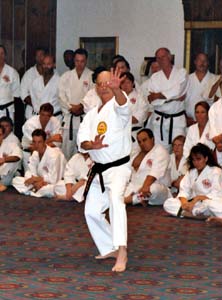
Kyoshi Perry demonstrates Rokusho |
The clinic concluded with a demonstration of a few basic Kata by members of the U.S. Chito-kai including a refresher on the Kihon Dosa and Kihon Kata that Hanshi Dometrich is planning on reintroducing into the curriculum. We were
honored to have Kata demonstrations by Kyoshi Perry and Kyoshi Merriman. Kyoshi Merriman demonstrated Tesho which shares roots with our own Sanchin Kata and Kyoshi Perry performed Rokusho which retains a very heavy Chinese
influence.

U.S. Chito-kai 2003 October Seminar L to R: Hanshi Dometrich, Kyoshi Merriman, Hanshi Tsuruoka, Kyoshi Perry |
The annual banquet and awards ceremony took place that evening. National recognition was given to the following individuals:
- Sensei of the Year - Tony Hedderman – Allegheny County Yoseikan Pittsburgh, PA
- Sempai - Laura Stith Deck, PhD – Yoseikan II Cincinnati, OH
- Nempai – Alec Macenzie, esq. – Frankfort Yoseikan
- Kohai – Eric Ernst – Hombu Dojo
- Ambassador – Don Schmidt – Hombu Dojo
- Outstanding Service Award – Kevin Drummond, Mike Messenger, Jackie Cross, Cindy Drummond – Bridgeport West VA
- Joe Petty Children’s Award – Linda Gage – Yoseikan Virginia
- Valor (Yu) – Shihan James Matthews – West Palm Beach, FL
- Comeback Award - Gerald Meade
The following promotions were announced at the banquet:
- Go Dan
o Cyna Khalily, MD
- Yon Dan
o Matthew Scott
o Eric Ford
o Willie Elliot
o Scott Dunn
o David Tollis
- San Dan
o Theresa Brandenburg
o Shawn Davenport
o Gerald Mead
o Don Schmidt
o John Wellbrock
- Ni Dan
o Ed Videck
- Sho Dan
o Brian Buirge
o Jackie Krah
o Julia Thaller
o Jackie Cross
o Gorden Levin
o Roy Moser, III
o Edgar VanHorne
o Theresa Hays
o Linda Gage
- Ik kyu
o Andrew White IV
o Kim Wegeford
o Cheryl Widener
Sumbitted by:
Cyna Khalily, MD
US Chito-kai
One Day Down in Texas
by Willie Elliott
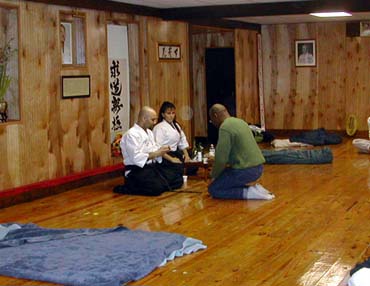
“One day down in Texas, when it was scorching hot and there was nothing to do, one guy took off all his clothes and ran and jumped into a cactus patch. Everyone ran over and asked why did you do that. He said, well
it seems like a good thing to do, at the time.”
The first thing anyone would ask me, a 56 year old man, why in the world would you subject yourself to six hours of grueling practice. My decision to attend kangeiko was motivated by my desire to serve as a role
model for three of my students. They were concerned about their ability to work out for that long a period of time. I challenged them by saying if a 56 year old man can do it, then students in their early and
mid-twenties can surely survive this.
It seemed like a good thing to do. As the above quote suggests, what starts off as a good idea, may not end up that way. The quote states that the man took all his clothes off, which represents the decision to take
kangeiko training. It goes on with the man jumping into a cactus patch—this represents carrying out the decision to actually sign up for kangeiko and then to actually show up and participate. And the pain suffered
after jumping alludes to the pain I suffered after six hours of continuous training. It really did seem like a good idea but looking back it was not a smart idea. But, I actually made the foundation for this decision
some 38 years ago. 38 years ago I decided to start training in karate. So this was no time to go back on that decision and all the history it represented.
Having such a wonderful dinner was a tribute to Okusan and Kathy Webster. This great meal helped my confidence and spirit to get ready for this test of endurance. What followed was a really good saki ceremony led by
Shihan Cyna Khalily. The most important point here was that he would lead by example. This was so uplifting because it was exactly the point I was trying to get across to my students. My biggest problem at this time, was
attempting to survive my cold feet. My feet were cold because of my age and chronic bone condition that does not permit sufficient warmth to enter my bones. At this time I was really feeling my age and the training had
not even started. However, I made up my mind that I would attempt everything that was thrown at us. But, I would move at a pace---that would sustain me through the six hours. My biggest concern: was staying focused on
each moment for six hours. The one thing I knew I could never do was the run at the beginning of the ending of kangeiko.
After kangeiko was over, I didn’t feel tired. However, I didn’t realize that my body was actually numb which kept me from realizing how tired I was. The realization came as a delayed reaction after my
drive home. I came home and thought I would lay down for a few minutes, I slept for 6 hours. But, all in all, what seemed like a good thing to do at the time, turned out to be wonderful, life changing thing after it was
all over.
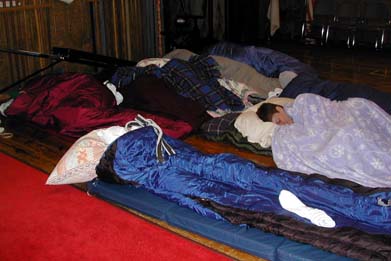
KANGEIKO 2005
By Linda Gage
When asked if I was going out to dinner for my birthday this year, my response was “As a matter of fact, yes.” My plans however were not what most thought. The dinner was a spaghetti and meatball affair sans the
wine. The
dessert was a 6-hour training session that we all know as Kangeiko. Now for most folks turning 53, this sort of activity would be ludicrous at the least. However, we karate-ka are of a different mind set! I would like to
share my feelings,
impressions and pain with you who can understand the fulfillment in celebrating a birthday in such a manner.
My student (one Richard Rike) and I arrived by plane on Friday to be met by “Wellbrock the Doc” Sensei at CVG. After a quick bite and a visit with Kramer Sensei, we headed for the Hombu. Three guesses who we
found in the kitchen preparing the sumptuous pre-Kangeiko feast??? You got it, Kyoshi Dometrich and sidekick Kathy Webster! Soon after, Hanshi arrived as well as other participants of these years’ Kangeiko. After a
fabulous meal, I was honored by Hanshi’s critiques of some of my kata…well, we really didn’t get past the first two moves of Taikyoku Ichi…(I promise, Hanshi, to fix those problems!) Just around
9:00, we were welcomed to the event by the “man in charge”. This year it was Khalily Sensei. His dynamic sister/sidekick, Ludwig Sensei, assisted in this most gracious “invocation” by pouring the sake
(make mine a double, please.)We “kampied” and soon went off to bed. Everyone slept as soundly as bugs in rugs (and if you believe that I’ll sell you a bridge in the Mojave Desert). 2:30 came along with the
“clap” and lo; we went about the business of teeth brushing, sleeping bag folding, and gi donning. Precisely at 3am the fun began.
After bowing in and mokusa, warm ups were delivered by Jansak Sensei. We were in pairs and I knew then that we were in for a night/morning of it! Next was the thousand “punch/kick event”. This was enhanced
by the fact that every time someone failed to count appropriately, we had to do ten push- ups. I believe we had around fifty in and amongst the punches. Following some makiwara training was kata. Khalily Sensei chose to keep
this an all “Chito-ryu” experience. Therefore we began with “Zenshin Kotai” and finished with “Seisan” with “Shiho wWare”, “Shihohai” and “Kihon no Empi”
in between. Now don’t think for one minute that we ran each of these kata a few times. We were told afterward that we executed 200 kata!! You do the math. At this point we worked some kaisetzu for “Seisan”
kata and segued into kumite drills of all sorts. We also did some two-man co-ordination exercises after which my forearms looked like I was a survivor of some sort of barroom brawl. The highlight of the morning came when
Khalily Sensei announced that Ludwig and Kembre Sensei were going to teach us “Chokusen” kata. In case someone may not realize, Hanshi created this kata years ago as a young police officer. The embusen is exactly
its name. It is a remedy for “hallway” conflicts. It is also a must know as a member of the US Chito-kai! Thank you so much Sensei!
Now you are probably thinking that it is time for the traditional outdoor cool down run around the block. Not quite yet. All 28 “Henshuho” were next on the agenda. At this point, I was almost completely
useless. For those of you who do not know me, a previous 25-year career as a professional ballet dancer has left my body full of unwanted injuries and arthritis. I was, needless to say, moving minimally. But, not the rest of
the gang. Everyone including Elliot Sensei, who is actually a few years my senior, put me to shame! Finally it was time for the morning run! It was icing and snowing and many of our dauntless (albeit, nuts) karateka did this
jaunt barefoot. I chose to stay indoors and Elliot Sensei and myself worked through several kata waiting the return of the intrepid class. We were on the last leg (me literally) of the journey, this being “Sanchin”
kata. After a review of the kata, we executed “Sanchin” as Khalily Sensei made his way around the room distributing the necessary blows to various body parts to test our focus. Finally, 9am came around and we
were lined up for seiza/mokuso.
Meade Sensei (who did not attend this year due to an injury) delivered the hot tea and Khalily Sensei delivered the most gracious congratulatory speech along with our certificates.
Khalily Sensei did a most magnificent job. He is certainly a gifted karateka and I have learned so much just observing his work. We are truly fortunate to have him in the organization.
Many thanks to all of my fellow participants, teachers, those who toiled in the kitchen (Kathy, you ARE something!) and of course to our wonderful Hanshi and Okusan.
And, yes, this is a must do event for everyone in the organization, no matter how old you are!
Kangeiko 2005
Loud and Proud, Revisited
By Mina K. Ludwig, Yon Dan, Yoseikan II
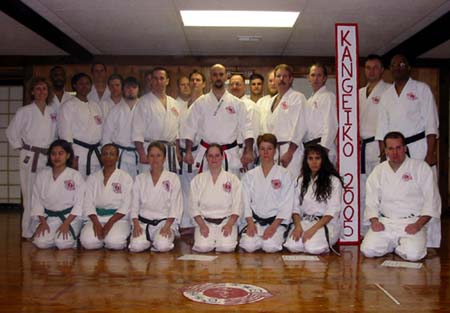
‘Recidivism’ is the tendency to fall back into criminal, delinquent or antisocial habits in spite of punishment or treatment. Is attending Kangeiko criminal, delinquent or antisocial? Well, no. But the lines of
intelligence and self-preservation become rather blurred. And so I sit tapping away at the computer, grinning like an idiot because I have to rigidly hold my arms and hands so as to avoid any contact to the multiple hematomas on
my forearms and elbows. In other words, I’m all banged up. In fact, my arms are more purple than flesh tone. My kids kissed my ‘boo boos’, and my husband smiled and shook his head. His eyes said, ‘Yeah,
and you’ll go back next year for more.’ Amen to that.
On January 28 and 29, the bell rang for Kangeiko 2005 and 24 eager karateka, answered that bell. The ages ranged from 15 to 56. Men and women were equally represented. As for rank, we were pleased to have a handful of green
belts and several brown belts along with the usual black belt suspects. Some veterans were injured and unable to participate this year. I feel badly for those vets because I know they were pining away, and they were forced to
miss one doozy of a Kangeiko.
Let’s start at the very beginning. All day on Friday, I looked forward to Okusan’s spaghetti and meatballs. I never learn to restrict myself to only a half plate. If I could just exercise some restraint and
intelligence, my dinner would not talk back to me during Kangeiko. Dumb, dumb, dumb. Ah well, it was worth it. Dinner conversation varied as usual, but since there were quite a few first-timers, there was considerable dispensing
of war stories and advice. Sleep in your gi pants and cuddle your gi top and obi. Big wide green belt eyes were full of ‘why should I do that Sensei?’ You’ll understand come 2:30 am, trust me.
Shihan Khalily was the ringleader of this year’s fun filled insanity. It was his first time running the show, but I think, and we all hope, not his last. Nice job bro. I can say without bias that Shihan borrowed a
page from Hanshi’s book and ran a seamless Kangeiko.
Shihan Khalily marked this Kangeiko with his own creativity and flare for tradition beginning with the opening ceremony at about 8:45 Friday night. Just for background, on Wednesday, Shihan called me and told me to bring my
hakima and my breakfast-in-bed tray. I don’t bother to ask why anymore. Almost everything you see me do with him, you can bet I just found out about it. Between the courtroom, my teacher and my brother, I’ve become
rather adept at winging it and/or hitting the ground running.
Shihan gave a very brief but inspiring introduction and welcome to Kangeiko 2005, proving that, indeed, ‘brevity is the soul of wit.’ To illustrate that he was willing to do everything we do and more, each
participant was invited to kneel before him, request either water or sake from me, and Shihan then drank a shot with them. (Yes, that was my job – to be a glorified flight attendant/geisha and ‘pour out’!) By
the way, no matter what the student drank, Shihan drank sake. Interesting strategy, eh? To each student he offered ‘Gambate kudasai! Hai, Kampai!’
Lights out at 10:00 pm. For more in-depth coverage of that farce, please refer to my article from Kangeiko 2004. Just as an update, I still can’t sleep before Kangeiko and everyone still has bladder problems. Either I
am a camel, or you all have issues. It’s only about 4 hours, and you are supposed to be asleep. Can’t you hold it in? We have a couple physicians who have offered to catheterize all retention-challenged participants
next year. Let me know if you are interested.
Once again, there is bad news for some. You snore like lumberjacks sawing logs. Yes, even among the women. Let us all endeavor to sleep on our sides next year shall we? No one can say I snored, remember, I can’t
sleep. 2:30 can’t come soon enough for me.
On deck before 3 am, and finally time to get the road on the show. On the chalkboard was a reminder: “There is no talking at Kangeiko.” That’s a good thing. What is there to talk about at 3 am? And let’s
face it, everyone could use a tic tac.
So what did we do? Well to really find out, you have to answer the bell. But here’s a little taste: 1000 punches (several of which delivered to the makiwara) and 500 kicks in the first hour; two hundred or more
repetitions of various Chito Ryu kata with detailed (though not wordy) instruction on all; an in-depth look at Seisan with Shihan’s interpretation of some very simple yet effective and deadly bunkai; blocking drills (hence
my purple arms); all 28 Hen shu ho; myself and Renshi Kembre spent an hour instructing on the Dometrich family kata created by Hanshi over thirty years ago, Chokusen, and; the traditional run followed by Shime no kata and
Sanchin kata.
The run bears more description. Shihan was the first out the doors followed by myself, both of us barefoot. (I’d say half of the participants wore shoes and half ran barefoot.) As soon as I stepped down and out,
Shihan yelled “ice!” and helped to stop my slip and slide. The entire alley was one big sheet of ice. We all managed to make it out to Scott Street without significant mishap. I remembered a cadence about Hanshi from
last year; Shihan did the various traditional spelling cadences and also (for those paying attention) created a Chito Ryu version of the Tony the Tiger cadence.
I had another cadence that I did not get to do because everyone was concentrating so hard on staying on his or her feet on the slippery terrain. Not a big deal except that I composed the cadence during Kangeiko, which I
think, means my life must be spared… or something like that. Since I think it fairly sums up the 2005 experience, I’ll record it here for posterity:
Late last night around a quarter to nine,
Shihan Khalily had us all in line.
Sake lined up in front of his sis.
Shihan emptied thirty with a flick of his wrist.
‘All of you sitting now before me,
You all have got to be crazy!’
Crazy, crazy, every one
Kangeiko is the way that we have fun!
A recidivist never learns. He or she is rather stupid, really. Actually, some would say recidivists are addicted to that which can do them harm. Edgar Allen Poe called this addiction or tendency the ‘imp of the
perverse.” Once you participate in Kangeiko, it’s hard not to become a repeat offender. It is a reaffirming experience. It takes you to the brink of what you can do physically and mentally. It pushes the limits and
raises the bar. It sets the tone and a precedent for the rest of the year. This is a taste of bushido, shugyo and nin. This is why we started on the path of karate. We should love to train for the mere sake of training. We
should love to train early, often, long and hard. Let’s not talk about it. Let’s not analyze it. ‘To know the way, we go the way.’
Thank you to Okusan and Kathy for the excellent vittles. Thank you to Shihan Khalily for the excellent instruction. Thank you to Hanshi and Kyoshi Dometrich for giving every Chito Ryu practitioner in this country the
opportunity to be a part of O’Sensei’s legacy. And thank you to my sensei, Kyoshi Hawkins, for teaching me not only Chito ryu, but also helping me to cultivate the Nin tai, or perseverance, required not only for
Kangeiko and daily karate training, but for every endeavor.
If you see the outstanding shirt commemorating Kangeiko 2005, notice the kanji for ‘Nin tai’on the back. Let us not forget that the Showa authored and mandated by O’Sensei emphasizes shugyo, bushido and
nin. Kangeiko is but one manifestation and a way of testing all three concepts. Let these three pervade your training throughout the year.
‘Study hard, young people, the way of Chito Ryu.’
Karate and Karaoke - Florida 2005
By Mina K. Ludwig, Yoseikan II
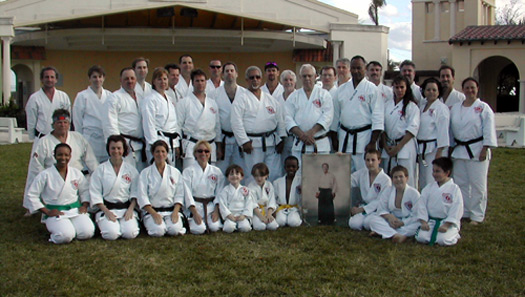
Rainy, cold weather after a long weekend of karate training in sunny Florida. Sigh… True, the down side to the Florida clinic is that you get a cold blast of reality when you get back home. Nevertheless, the clinic is
a great winter oasis and is well worth the trip, not just for the weather but, more importantly, for great training and great fun with our U.S. Chito Kai brothers and sisters. (did I mention that the great training and fun
take place in 80-degree sunny weather?) If you have never been, here’s a little synopsis to wet your whistle.
Thursday night is a regular class night for West Palm Beach Dojo. The class was comprised of several young and some less young, but equally enthusiastic, students who seemed thrilled to have guests come to visit and
train. Kyoshi Hawkins headed up this class concentrating on basics, principles of movement and sources of power. The underlying focus of the class was precision and the need for superior effort and perfect execution of every
technique.
After class we proved that after working hard, playing hard is certainly in order. Work and play in proper balance and perspective. In this context we conducted a case study of the principles of yin and yang (that would
be one way of explaining it). Without that bit of spin-doctoring, it was just good clean fun. There was karaoke involved, and, by the grace of God, no cameras or recording devices. Enough said.
On Friday, we enjoyed a two-hour clinic in the park adjacent to the hotel. Hanshi and Sensei Mike Messenger worked the group on kumite principles. As always, the training was rewarding and beneficial to all. As you
might imagine, we drew quite an eclectic crowd of onlookers.
Friday night Hanshi, Okusan and 14 or more companions made their way to an Italian restaurant where, by all accounts, the food was plentiful and good. A few die hards (yeah, I was with them) returned to the scene of the
karaoke crime to listen to some live, legitimate, talented music.
Saturday morning we enjoyed the traditional 7 am workout on the beach. We had a nice crowd of participants as well as the usual fascinated onlookers. The focus of the training was Niseishi kata and bunkai. Loose sand
makes for a cushiony breakfall, although it leaves sand in some interesting places. Imagine working kata on the beach with the rising sun and Hanshi belting out the cadence. That’s good stuff.
Several hours later, around 35 students from Covington, West Palm, Cincinnati, Orlando, West Virginia, North Carolina and a couple welcomed guests from St. Petersburg came together for three hours of training under
Hanshi’s direction and guidance. After several rounds of deck drills, Hanshi emphasized kumite principles with a focus on varying hard vs. soft blocking and counter-attacking. Upon request, Hanshi worked the group on
his kata, Chokusen. Although Hanshi gave everyone permission to forget the kata - just this once, don’t listen to him. One of our co-founders created a kata and we should all learn and remember it. It’s a gift.
Let us treat it as such, be grateful and take care of what we’ve been given. If you don’t know Chokusen, someone in your dojo likely does.
The clinic ended with Hanshi regaling us with stories about O-Sensei. His love and devotion to his teacher was apparent and, as usual, inspiring. Not many people can say they spent 50+ years complying with their teacher’s
wishes. Not many would or could devote nearly three quarters of their lives to promulgating the teaching of their Sensei. Precious few Caucasians could say that they had extended and direct instruction from O-Sensei and that
he personally tested and awarded them the rank of Sho Dan. I think Hanshi is the last of those Mohicans. Can you imagine having a black belt certificate bearing the signatures of O-Sensei, Gichin Funakoshi, Kanken Toyama and
Seiko Higa?
If those names mean nothing to you, you might consider reading a bit more, but more importantly, understand that Hanshi has a very distinguished and legitimate upbringing and credentials in Chito ryu. Undisputed really.
Who can say that they had one on one discussions with O-Sensei and a translator? The discussions were not an exchange of pleasantries, but the type of discussion between student and teacher. This was and is a special
relationship. The teacher student relationship is sacred and not to be tread upon. Anything that disparages that sacred relationship or purports to cast shadow or doubt about a student’s true, honest devotion to his
teacher and to the accurate transmission of teaching to subsequent generations should be set aside.
The bottom line? Don’t come between me and my teacher. I’ll pay you the same courtesy. If you come across someone whose teacher has passed away, the ante goes up ten fold. Hanshi has nothing but pictures,
notes and heartfelt memories of his teacher. Don’t mess with that. If you hear someone disparaging anyone’s devotion to their teacher, understand that this is the ultimate of insults and is excruciatingly
disrespectful.
Hmm…did I digress? Allow me to segue back to sunny Florida…
At the post clinic banquet we celebrated the spirit of devotion to our respective sensei. Shihan Matthews, who founded the West Palm school but has recently relocated to North Carolina, was awarded a plaque by one of
his earliest students from West Virginia, Mike Messenger. Thanks a lot, Mike, for making me get misty in front of my Sensei. Naturally, Hanshi and Okusan got standing ovations for their time and contributions. In addition,
Kyoshi Hawkins gave an eloquent yet succinct talk about ‘why we are here.’ We joined this organization to train. Later we learned that through hard, diligent training and devotion to our teacher and fellow
karateka, we hone our personal character. When we get wrapped up in things that have nothing to do with our training, we lose sight of our purpose. When you lose sight, you can easily become lost or led astray.
More fun, dancing and partaking of moderate social endeavors. Yea, yea the usual. I need a vacation from my vacation.
On Sunday we rounded out our training to ten hours with another morning workout. Kyoshi Hawkins led this class which concentrated primarily upon Seisan kata and some bunkai. As always, precision was held to a premium. I’ll
take a lesson from my teacher any time.
That’s where my story ends although Hanshi and Okusan traveled on to Orlando for a Monday night class with that enthusiastic crew. Those two are absolutely relentless. My sources tell me that Hanshi worked them on
Shihohai, the bunkai, side snap kick and the kihon dosa katas. Around eleven students were most pleased to have received yet another opportunity to train under Hanshi. As Sensei Binkley put it, despite having been ill for
the past three weeks, driving to Florida and teaching four classes, Hanshi demonstrated “great passion for the art and his students” as well as a tireless devotion to passing on his knowledge.
Thank you to our hosts for the many hours of preparation and the warm reception and hospitality (including rides to and from the airport!). We enjoyed ourselves immensely.
Next stop - March clinic. Try not to miss that one. This is a big birthday for Hanshi. With spring just around the corner, the start of a new decade for Hanshi is a time for new beginnings and new hope. Let’s be
there to help him to celebrate in grand style and to further our study of the principles of yin and yang….work hard, play hard. No karaoke, please!……………well, okay…maybe.
Auspicious Beginnings
Mina K. Ludwig Esq.
‘Auspicious’ may be defined as ‘giving promise of good fortune.’ It is a good word to use around the Spring Equinox. At a time of renewal, reaffirmation and rebirth, one should look positively toward
the future. And so, on Friday March 18, members of the United States Chito Kai began the formal celebration of a very important anniversary date. March 15, 2005 marked the 70th anniversary of Hanshi Dometrich’s birth.
The entire weekend served as a most ‘auspicious’ and uplifting beginning to Hanshi’s eighth decade of life. Before the karate festivities on Saturday, however, there was business to attend to secure the
future of the U.S. Chito Kai.
Truthfully, Friday evening does not really qualify as business; however, around eighteen shihans and dojo heads and their guests were honored to attend a dinner arranged by Sensei Elliot and hosted by the President of
Northern Kentucky University in honor of Hanshi. Lest you think I crashed the event, I had the nod from Okusan to serve as my brother’s escort. Actually, I probably could have gotten in with my ‘press pass’
but I don’t think roaming reporters get to eat. That would not work out at all.
The Dean of Professional Studies for Northern Kentucky University graciously welcomed us all. Among the presentations, the Vice President for Academic Affairs presented Hanshi with a plaque from the President of NKU
which exulted Hanshi’s fifty years of teaching and passionate devotion to passing on O-Sensei’s legacy. The President and staff of NKU congratulated and thanked Hanshi for his lifelong contributions to his
students, and for his civil service to the community and to the United States of America. Such appreciation and recognition from individuals outside of the U.S. Chito Kai is extremely gratifying and serves as a reminder and
affirmation to those within the organization. There has been, and is ever, greatness in our midst.
We also heard from our ever-eloquent Chairman, Kyoshi Hawkins. In a nutshell, Kyoshi urged us to keep our cup empty. There is more to learn if you remain open and flexible. Shed the concept of ‘entitlement’
and devote yourself to training. Frustrations, plateaus, conflict and the like are inevitable. After all, the course of human relationships never runs smoothly. Each of us, however, is charged with the responsibility of
self-mastery. We can consider our karate training the lifeline by which we can pull ourselves up and out from the pitfalls of human frailty.
Our Vice Chairperson, Renshi Kembre, again delighted us with personal stories about Hanshi. She graciously and unselfishly continues to share her parents with the rest of the U.S. Chito Kai. On a more official but no
less delightful note, Renshi presented an antique DNBK medallion along with a letter of good wishes and praise from the International Division of the DNBK, thanking Hanshi for his contributions to the
DNBK and calling him a ‘gentleman of all seasons.’
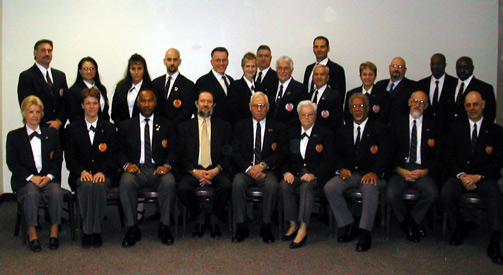
We also heard from Shihan Matthews who, along with his lovely wife, traveled from North Carolina to help Hanshi celebrate his birthday. Shihan echoed the sentiment that hard work and devotion have their own rewards. We are
the beneficiaries of our own travails and can pass this wisdom and benefit on to the next generations. He was also kind enough to share his tattered old, sho dan test form - hand written by Hanshi. (Shihan, are you sure you
passed that test?) Shihan says he pulls that test form out anytime he starts to think too much of himself. I think we all have a test form or two that might bring us down to earth.
Unlike us, Hanshi Dometrich was tired of hearing about himself and, instead, thanked Okusan by handing over the Presidential plaque to her. He also enjoyed reading some of his hand written notes from an
antiqueified-looking steno pad. (yes, that is now a word – ‘antiquated’ doesn’t justify how old and tattered this thing was) Apparently, a few decades ago, Hanshi sat down with Shihan Matthews in West
Palm and wrote an entire steno pad of technical and philosophical advice. Aptly, Shihan refers to it as his treasure.
Okay, party over. Back to the same room by 8:30 am Saturday morning for a historic first meeting of the U.S. Chito Kai Board of Directors. The Board of Directors is a new entity which combines the Shihan kai and the Shibu
kai. Each Shihan has one vote. Each dojo head has one vote. Those who are both a shihan and a dojo head have two votes. I was privileged to attend and participate as a member of the judiciary. (No vote, but a lifetime tenure
– so tread lightly people!) A quorum of the Board of Directors was present, with representatives of dojos from Kentucky, Ohio, Virginia, Florida and West Virginia.
We spent two hours reading and discussing at length the new Constitution and By Laws. Both documents were crafted with clarity and designed for longevity. These will be lasting documents which will provide guidance for
the future of the U.S. Chito Kai. It is important to understand that we are all involved in a personal journey as karateka studying Chito ryu. We are also, however, members of a group venture or organization called the U.S.
Chito Kai. The existence, strength and health of the organization facilitates, cultivates and promulgates Chito ryu among its current members and within the martial arts community. These governing documents will be made
official in their final form in October.
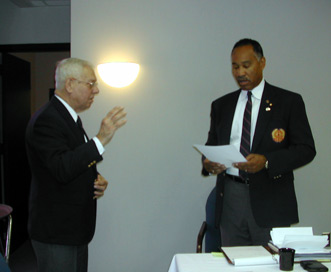
The organizational structure, process of elections, nominations and terms of office are more democratic than one would expect possible in a traditional martial arts organization. The tone and tenor of the meeting was formal,
businesslike and yet congenial. It was an extremely productive meeting in which questions and comments were welcomed and addressed, yielding genuine satisfaction for all in attendance.
The official business of the day was to vote on all persons currently holding office. Hanshi administered the oath of office to myself and chief judge, Shihan Matthews, as members of the judiciary. I had the honor of
administering the oath of office to my teacher, Kyoshi Hawkins for the office of Chairman. He, in turn, had the honor of administering the oath of office to his teacher, Hanshi, for the office of Chief Instructor. He also
administered the oath to Okusan as Chief Administrator and to Renshi Kembre as Vice Chairperson. Finally, the entire Board gave their oath. Everyone recited the same oath which stated in pertinent and memorable part “On
this oath, I stake my honor.”
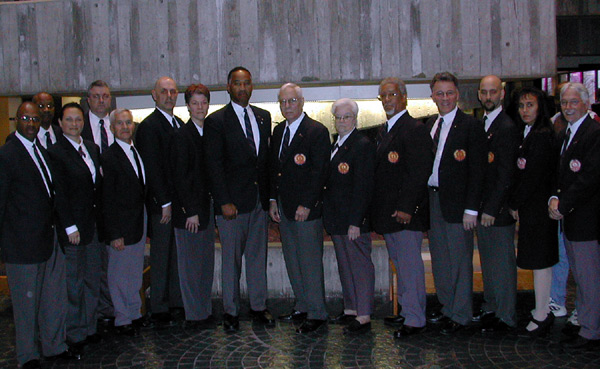
Outside, it was damp and cold, but following the meeting, spirits were high - buoyed by our well-founded hopes for a bright future. It may not look like Spring, but it soon will – Hanshi’s seventieth Spring. In
the meantime, let’s train and enjoy our languorous but hopeful progression through what we have chosen as our lifelong quest. Let each of us enjoy our time with each other and be grateful for those teachers and leaders
who have devoted much of their lives to us.
You breathe; new shapes appear,
and the music of a desire as widespread
as Spring begins to move
like a great wagon.
Drive slowly.
Some of us walking alongside
are lame!
- Rumi, 1207-1273
Spring Clinic 2005
Cyna Khalily, MD
Every March the US Chito-kai holds a clinic and banquet in celebration of Hanshi Dometrich’s Birthday. While every year is special with regards to the birth of our Founder, this year marked a special milestone in that
Hanshi turned 70 years old. What better way to celebrate than a weekend of Karate training among extended family and friends? The weekend kicked off on Friday evening with a celebratory dinner in honor of Hanshi at Northern
Kentucky University hosted by Vice President and Provost Gail Wells and Dean of Professional Studies Patrick Moynahan. This dinner was attended by the newly formed the Board of Directors of the US Chito-kai. After the
various convocations by the NKU administration, Renshi Sherry Kembre, as Secretary of the Midwest DNBK, presented Hanshi with a rare antique DNBK lapel pin as a personal gift from Hanshi Tesshin Hamada.

The clinic was held on the campus of NKU in a new multi purpose room. What a nice venue! This large room was perfect for a karate workout – a brand new hardwood floor and lined with mirrors on three sides. It was large
enough, but not too big, so it still felt like an intimate class even though there was plenty of room for the 80+ participants. This year there were a few special guests in attendance: Shihan Lloyd Johnson, Goju-ryu with 6
of his students from Louisville and New Albany, Sensei Robert Brown, Goju-ryu, from Danville, KY, Sensei Ronald Beshers, Shito-ryu of Elizabethtown, KY and Sensei Kamau Akil Chukwueneka of Louisville, KY.
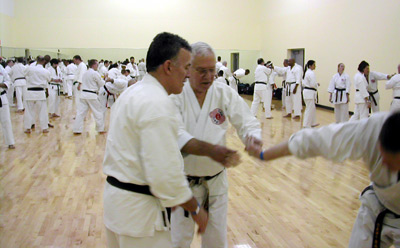
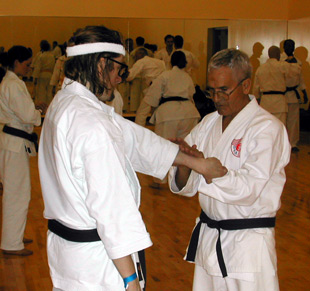
Hanshi personally taught the entire clinic. He started the group off on a few basic drills for warm-up and then moved into basic Chito-ryu exercises and more advanced stepping drills such as hanten and rinten turns, tsuki
kaeshi and dachi no waza as well as the Kihon Dosa kata. The nature of these drills all had the common theme of “Tenshin” or body turning and pivoting. The remainder of the clinic was spent in partner drills.
Hanshi explained that the pillars of karate are Kihon, Kata, and Kumite, and to that he adds Kai Setz. Expounding on the theme of body turning and kai setz we started with the Hanten ho – or half body turns. From there
we progressed to the Rin ten ho – or full body turns and then onto Te ho doki. The basic concepts of these exercises are universally applicable so that everyone for beginner to advanced students had something to
practice. The non-Chito-ryu practitioners caught on quickly and were able to get a taste of what Chito-ryu is all about. The partner drills also gave everyone the opportunity to train with each other, renew old
acquaintances, and form new ones.
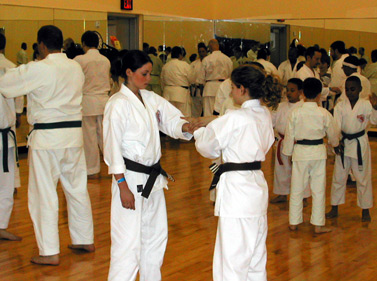
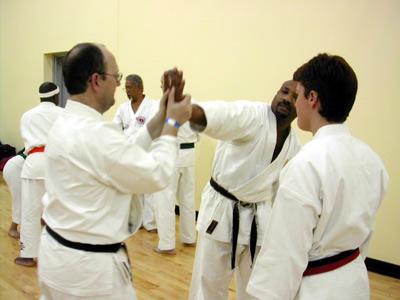
At the end of the clinic we were treated to kata demonstrations by a few of our guests as well as a reprise of a couple of the Dai Nippon Butoku Sai kata performances. Hanshi also presented Sensei Brown and Sensei Beshears
with their DNBK certifications. All participants were presented with a comprehensive handout that illustrated everything covered in the clinic as well as the Henshu ho – these are pages taken directly for the newly
revised US Chito-kai Instructors manual. As a special birthday tribute to Hanshi, Sensei Mina Ludwig closed the clinic with a performance of the Hanshi Dometrich’s kata Chokusen.
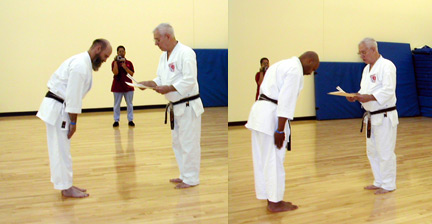
That night we gathered for a catered banquet at Hombu, the place was definitely filled to capacity. There were many well wishes for Hanshi’s birthday. Kyoshi Hawkins made a nice introduction with a plethora of factoids
regarding 1935 – a lot of stuff happened that year, but most of still agree the most significant event was Hanshi’s birth. There were lots and lots of gifts and cards, the theme this year seemed to be an effort to
finance Hanshi and Okusan’s wanderlust, with the rising price of gas these were good gifts. Always with a little bit of selfishness though, everyone wants them to visit their town and Dojo! All in good time!
Thanks to Sensei Willie Elliot for securing the NKU facilities, they are first rate. Thanks to Cathy Webster and the Hombu crew for making the dinner happen. And thanks to Okusan for all the planning and implementation, as
always, couldn't do it without her.
A Fish Out of Water ( Learning to Play Violin)
Cyna Khalily, MD
For most Louisvillians, the first Saturday in May means only one thing – The Kentucky Derby. Being the samaritan that I am, to make room for the temporary population surge, I always leave my adopted hometown on Derby
Day. Now, lest you think that my motives are purely altruistic, allow me to fully elaborate. The first Saturday of most months – May or otherwise – is already spoken for in my little world. The first Saturday of
the month is Black Belt class at the US Chito-kai Hombu. While I will not disagree if you call me shallow or narrow minded – both true – I would argue as to why any self respecting Budoka would pass up the
opportunity to reconnect on a monthly basis with the ranking Chito-ryu karate-ka in the US? Particularly in May, which marks the last BB class before the summer hiatus? Derby Shmerby – the Hombu is a sure bet
everytime! (Although, I wouldn't have minded a piece of that 50-1 winner this year). Apparently the 30+ attendees of this days class also have similar priorities.
This time around we had the distinct pleasure of guest instruction from Master Mak Lau. Master Lau was accompanied by one of his students and we had the further pleasure of several visiting Shotokan guests including
Shihan Dwight Holly, Sensei Ron Johnson and Sensei Hugh Willis. Sifu Lau will celebrate his 80th birthday this year, and for well over 50 years he has been studying Chinese Gung fu – in particular Tai Chi Chuan and Chi
Gong. Renshi Jerry Beshears is a student of Sifu Lau. The mutual respect and admiration between Hanshi Dometrich and Sifu Lau is apparent – quality recognizes quality I suppose. For as many years as I can remember,
Hanshi has sung the praises of Sifu Lau, and for the few years I have known Mr. Lau, he has always spoken with great reverence of Hanshi Dometrich. So this was a long overdue and welcome privilege for the US Chito-kai.
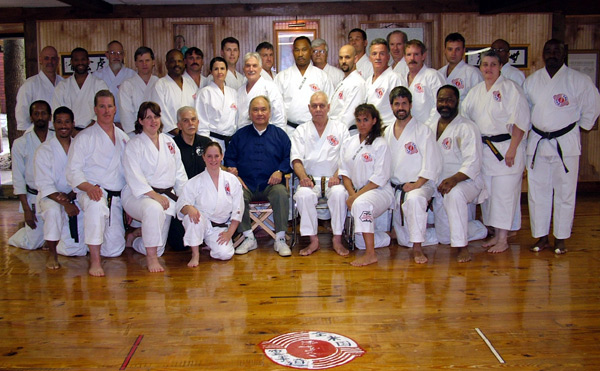
Master Lau started by explaining the meaning of Tai Chi Chuan. He believes that while the class was composed of well-trained athletes and superior Karate-ka, Tai Chi Chuan was different. He drew the analogy that although we
may all be concert pianists, and no one would argue that the piano makes beautiful music, he was a virtuoso violinist and would show us that the violin is also capable of producing a beautiful, albeit different, melody. He
explained that Tai Chi is an abbreviation that does not make much sense in translation, and that properly translated, Tai Chi means “Most Supreme” and Chuan means “Fist”. He said that the mysterious
and mythical connotations associated with Tai Chi Chuan are simply not true, and that Tai Chi Chuan is very straightforward. To him, Tai Chi Chuan is a form of exercise, but so is running or weight lifting. Why Tai Chi
Chuan? Master Lau feels that Tai Chi Chuan not only involves physical exercise, but also improves balance, breathing, strength, coordination, discipline, and most importantly sensitivity. Of course there is a Martial aspect
also that is missing from other forms of exercise. Master Lau treated us to a short demonstration of a portion of a Tai Chi Chuan form, the untrained eye would perhaps be unimpressed, a fact that does not escape Master Lau.
He elaborated that performing the techniques in a slow controlled manner, with the knees bent the whole time, will prove challenging to any well trained athlete. He also explained that the slow movements and concentration
help develop sensitivity, both spiritually as well as physically, the Tai Chi Chuan adherent can “feel”. The Martial application of these “slow motion” techniques are summed up in the ancient Chinese
saying “gather your power like pulling a bow, release your power like releasing an arrow”. So, points out Master Lau, the slow movement represents a gathering of power, like continually winding a spring, and it
the space of a heartbeat the power can be released.
Master Lau put to bed another mysterious connotation, that of Yin and Yang – no mystery explains Master Lau, it is simply convenient Chinese terminology for opposites – Light and Heavy, Up and Down, Bright and
Dark. Only by knowing the Soft can one really know the Hard. The entirety of Tai Chi Chuan is based on the concept of Yin and Yang. While it may look easy, it is quite sublime; there is always a Yang foot (heavy, root) and a
Yin foot (light, moving), there is Yin hand and a Yang hand. Always Yin and Yang in play, always coordinated and always simultaneous.
 |
Master Lau then treated us to a demonstration of “Sticky Hands” exercise, with the assistance of his students. At one point I saw a smirk on one of the students face and he motioned for Renshi Beshears to be ready to
catch him. Apparently he has been on the receiving end of Master Lau’s Ki (Chi in Chinese) and was trying to avoid hard contact with the wall, fortunately for him this time Master Lau didn't feel the need to demonstrate
this technique, although as long as someone else was his partner, I would have liked to have seen it. Master Lau briefly touched on the concept of circular power - deflect, redirect and return force. He also demonstrated a
movement very similar to our own Tai Sabaki #2 with a counter attack with a practice partner. After class, the unfortunate recipient of the demonstration, rubbing his ribs, was heard to say “It might not look like it, but
Master Lau has a lot of power”.
Then came time for the class of well-trained, high ranking Karate-ka to try out the techniques. Fish out of water. Think it is easy to demonstrate “soft”? Not when the majority of your training has been about
speed snap and kime. Think the steps of the Tai Chi Chuan form are simple? Do it slow, with correct posture and knees bent and your quadriceps muscles will tell you different. And think Sticky-Hands looks easy? Forget about
it. A taste of Tai Chi Chuan not only gave us all more respect and insight for “playing the violin”, it also reinforces our humility and Sho Shin “beginners mind”. The Piano is great, but there is a
whole orchestra out there, thanks to Hanshi Dometrich and Master Lau for introducing a bunch of Fish out of water to the Violin!
GOOD OLD-FASHIONED KARATE
Don Schmidt, Hombu Dojo
Soke Takayoshi Nagamine visited his good friend Hanshi Dometrich at the Hombu on July 14, 2005. The respect and admiration they have for each other was evident by the accolades they directed to each other. They initially met
in the 1960’s and helped each other work on their dojos as they continued their legendary journeys along the karatedo path. Hanshi Dometrich considers Soke Nagamine a “karate brother” and Soke Nagamine
referred to Hanshi as the best non Japanese karate teacher in the United States. Each expressed to each other their dedication and contribution to karatedo. With all the accolades they shared, their demeanor proved that
neither of them had lost the beginner’s mind and they often commented on how they are still learning and striving to better understand karatedo.
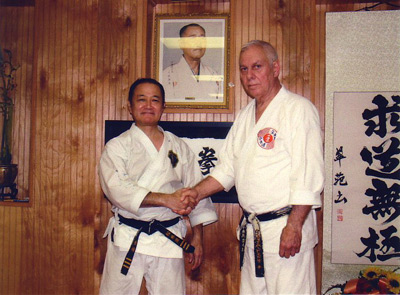
Soke Nagamine was accompanied by Sensei Don Sonney who teaches Matsumura Shorin-Ryu in Columbus, Ohio. Matsumura Shorin-Ryu is an Okinawan style of karate based on the teachings of Bushi Matsumura Sokon who was the maternal
great-grandfather of Master Tsuyoshi Chitose. Soke Nagamine is the head of World Matsubayashi-Ryu which is an Okinawan karate organization founded by his legendary father Master Shoshin Nagamine. In Naha, Okinawa, Master
Shoshin Nagamine was a boyhood friend and karate student with Master Tsuyoshi Chitose. The names of the great masters who learned karate in Okinawa have been written about in many books, most of which are in our library.
It is an awesome experience to be involved in a karate class taught by two direct disciples of the Okinawan Masters Tsuyoshi Chitose and Shoshin Nagamine who began their karate training in Naha. Receiving karate
instruction from Soke Nagamine and Hanshi is akin to being taught by Willie Mays and Mickey Mantle on how to hit a baseball, receiving quarterback instruction from Roger Staubach and Johnny Unitas, or receiving a golf lesson
from Arnold Palmer and Jack Nicholas.
Soke Nagamine provided a brief description of his style of karate by emphasizing the “snap” of his style as compared to Gojo-Ryu and Uechi-Ryu that are hard styles. Soke demonstrated the “snap”
of his style by cutting two pencils with a business card held only inches from the target and he emphasized how he extends his joints for greater snap and reach. Soke stressed that training for a minimum of 30 years is
essential to understanding and executing “joint extension” and he ran the class through some exercises to maximize joint extension. These exercises are similar to an exercise Hanshi has led his students through
that involves repetitive jabs with the left and then the right. The class progressed into kata. Sensei Sonney demonstrated his style’s version of Seisan which was followed by our Seisan and Shotokan’s version
known as Hangetsu. The similarities in the katas were evident as were the subtle distinctions and variations. Soke performed a sai kata. As Hanshi has said, we are all karate cousins practicing good, old-fashioned karate.
The advanced ranks joined Soke Nagamine and Hanshi on the upper deck where we continued to perform kata and compare the similarities between the styles. The class became an open forum when students were encouraged to
ask Soke Nagamine questions. The open forum was complete with demonstrations and applications. Soke Nagamine stressed that speed, relaxation and a strong center, or tanden, were essential to executing good technique. In
other words, Soke was conveying the same message as Hanshi expresses in some of his phrases like “speed or you’re dead”, “relax, relax, relax” and “drive with your hips”. Nothing
magical. Just good, old-fashioned karate!
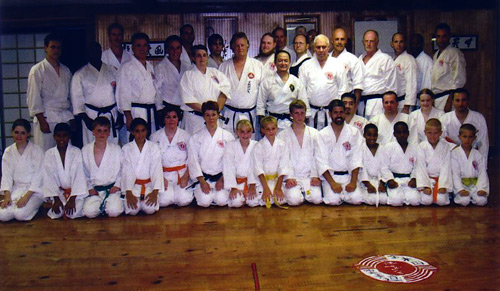
The open forum session also included bunkai from Passai, Chinto, and Tenshin. Soke Nagamine stressed that kata have hundreds of applications hidden in the specific moves and he shared with us his interpretations of certain
kata moves. More good, old- fashioned karate!
The two hour class was seemingly over a minute after it started. If you are wondering when you can get training like this again, come to the next class. Hanshi Dometrich may be teaching and you likely will hear from
him, or his instructors, “speed or you're dead”, “relax”, “drive with your hips”, “good posture/balance” or “use your center”. Come to the next class and you will
continue to receive good, old-fashioned karate instruction. Nothing magical and you will sweat if you put forth the effort to learn.
Thank you Soke Nagamine and Hanshi for your continued efforts to learn and teach karate as taught to you by your teachers.
A Time-Honored Tradition
Shochugeiko, 2005
By: Mina K. Ludwig, Esq.
“The sky is a huge dome.
Greenery is everywhere.”
- Dr. Tsuyoshi Chitose, O Sensei
On July 23, 2005, 81 members of the U.S. Chito Kai gathered to share in a summer training session steeped in history and tradition.
Shochugeiko can be traced back to 1896 when Jigoro Kano launched the first official and/or publicized Shochugeiko at the Kodokan. Two years after the first Kangeiko (winter training) was officially launched in 1894,
Shochugeiko was the next logical step in extreme element-enhanced endurance training. Certainly, bodoka had been training in the elements for centuries. Through Jigoro Kano's far-reaching influence, however, the 'modern' budoka
is encouraged to make a concerted effort to train arduously during the most extreme weather conditions. Lest we get too complacent and comfortable, lest we complain - Mother Nature takes us to task.

After five hours of training in the blazing hot sun, with a heat index of over 100 degrees, in a field full of molehills, I sincerely doubt anyone will complain about a two-hour class in a dojo of comparatively mild temperature.
Let's recall that the having a building and a deck is a luxury. Even if you didn't know about O Sensei's backyard dojo, the opening line to 'Study Hard Young People' reminds us that he never intended us to become what our fellow
budoka Dave Lowry would call 'dojo bushi.'
Mother Nature cooperated with Hanshi and after two weeks of near daily rain, it seemed as the though a magnifying glass was held over the field to intensify the abundant sunshine. It was gratifying to see everyone working so
diligently and without complaint. When forming our lines, no one tried to get to the comfortable shade of trees. We didn't show up for shade. We showed up for hot, tough training and we got what we came for.
Shihan Khalily kicked us off, so to speak, with warm ups and basics. During this segment we worked renzoku waza, zenshin kotai, kihon no empi and shime no kata. The pace and instruction was such that the white, yellow and orange
belts along with all of our welcomed guests had little to no problems following along. The first hour flew by and set the stage for a great day of training.
For the second hour, the group was divided for more targeted and personalized training. The white, yellow and orange belts got some concentrated training on Taikyoku kata from Shihan Khalily. The green belts received detailed and
very helpful instruction from Renshi Wilhelm and Sensei Ford on Sakugawa no kon sho. Students under the age of thirteen were fortunate to receive kata instruction from Sensei Laura Deck, PhD. Black and brown belts were similarly
fortunate to have Renshi Beshears at the helm instructing on the basics of kazushi, or unbalancing. As you might imagine, ironically, Jigoro Kano's theories on taking the opponent's balance were discussed. O Sensei held a high
rank in judo (we believe eighth dan) and fostered great respect for Jigoro Kano. Given the historical backdrop to Shochugeiko, this was a very apropos segment.
 For the third hour and a half, there was a changing of the guards. Black and Brown belts worked Sakugawa no kon sho. We can look forward to the manual which Renshi Wilhelm and Sensei Ford have been diligently working on. The
green belts worked on Niseishi kata and kai setz with Shihan Khalily. The white, yellow and orange belts worked on moving from the center, strengthening the tanden and theories of kazushi with Renshei Beshears.
For the third hour and a half, there was a changing of the guards. Black and Brown belts worked Sakugawa no kon sho. We can look forward to the manual which Renshi Wilhelm and Sensei Ford have been diligently working on. The
green belts worked on Niseishi kata and kai setz with Shihan Khalily. The white, yellow and orange belts worked on moving from the center, strengthening the tanden and theories of kazushi with Renshei Beshears.
The last hour and a half ended as strongly as the first hour. White, yellow and orange belts got an unexpected treat and worked with a bo. Green belts worked on kuzushi principals. Black and brown belts worked Seisan and Passai
with great emphasis on simple yet highly effective bunkai. Some sage advise from Soke Nagamine who recently visited the Hombu was that for the first twenty years or so of training, train with your heart and throw yourself
headlong into just doing it. Let your training remain relatively unfettered by intellectual analysis. The applications provided by O Sensei are probably more than sufficient at this stage of the game. After a couple decades, you
might be ready rev up your brain and figure out what the heck you are doing.
(editors note: Since the Niseishi Kai Setz contains 6 possible applications for a single opening movement, and the Henshuho demonstrates 28 different responses to a simple lunge punch, that must mean O Sensei believed there
are multiple application possibilities for each move. Khalily - webspinner) As a guideline to studying bunkai, if it works, it's not wrong. Likewise, if you can't make it work, get back to the drawing board. The
possibilities are endless and efficacy is highly subjective. Size and relative strength should factor into your personal analysis of your kata.
As usual, the picnic meant abundant food, drink, stories and laughter. We all slept well Saturday night and woke up with nice sun-kissed faces.
Thank you Renshi Wilhelm, Renshi Beshears, Shihan Khalily, Sensei Ford and Sensei Deck for the excellent instruction. Thanks to the Websters (our grill masters!) and everyone who contributed to the set up, content and clean up of
the picnic. Thank you Hanshi and Kyoshi Dometrich for orchestrating the entire event and for, as usual, providing the presence and additional motivation to strive for excellence. We all keep working up towards a level of
proficiency purposely set just beyond our reach - always just beyond so that we never become complacent with the status quo or for that which is easily attained. Thank you also to our co- founders for continuing this
time-honored tradition of summer training.
Next stop? Take me home country road to West Virginia. By the way, whoever is on the other side of the river from me holding the tug o' war rope…you're going down my friend. Please prepare for the plunge. Um…all you
big dudes, you're on my team.
WEST VIRGINIA SUMMER CAMP OUT AND CLINIC
By: Steve Wilhelm, Hombu Dojo
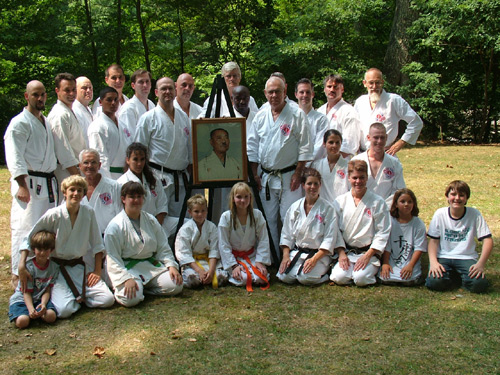
John Denver sang “Almost heaven: West Virginia” and it certainly was true, at least when it came the 2005 Audra State Park Karate Weekend, sponsored by the Bridgeport, West Virginia Yoseikan Karate School, August
12th, 13th and 14th.
The setting was Audra State Park (www.audrastatepark.com), located in north central West Virginia, just a few miles south of Clarksburg. Located along the banks of the scenic Middle Fork River, the park offers excellent camping
in the heavily forested campground, hiking through the woods in the surrounding mountains and outstanding and exciting swimming in the pristine waters of the Middle Fork River.
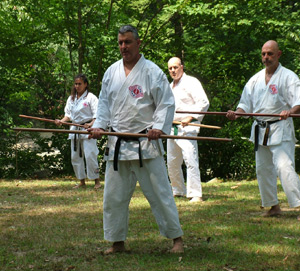 The event was attended by approximately thirty-five karate students of all ages and experience levels, and led by Hanshi Dometrich. Most of us arrived throughout Thursday and Friday, allowing us to take advantage of the park’s
facilities and to do some socializing with our Karate brethren before the seminar on Saturday morning. We were pleased to see folks from Hombu, Louisville, Cincinnati and Fort Bragg Dojos. The latter included Mr. Ricky Glass and
Mr. Richard Partida, both currently on active duty with the United States Army, and students at one of our newest affiliated dojo headed by Sensei “Po” Pochinsky. On Friday evening a traditional West Virginia style
Italian dinner was hosted by Cindy Drummond and Jackie Cross, and held at Uncle Phil Messinger’s house, across the river from the park.
The event was attended by approximately thirty-five karate students of all ages and experience levels, and led by Hanshi Dometrich. Most of us arrived throughout Thursday and Friday, allowing us to take advantage of the park’s
facilities and to do some socializing with our Karate brethren before the seminar on Saturday morning. We were pleased to see folks from Hombu, Louisville, Cincinnati and Fort Bragg Dojos. The latter included Mr. Ricky Glass and
Mr. Richard Partida, both currently on active duty with the United States Army, and students at one of our newest affiliated dojo headed by Sensei “Po” Pochinsky. On Friday evening a traditional West Virginia style
Italian dinner was hosted by Cindy Drummond and Jackie Cross, and held at Uncle Phil Messinger’s house, across the river from the park.
Saturday morning the seminar commenced with a lecture from Hanshi Dometrich in which he stressed many of the philosophies and technical aspects unique to Chito-ryu Karate-do. Some of the notable points were the priorities of
Karate practice as outlined by O-Sensei Dr.Chitose: first is the family, second is work or school, and the practice of Karate-do is only third priority. Also discussed were the various means of making power; a comparison of
speed versus power; and the observation that loyalty is an inherent quality with which someone is born. Hanshi Dometrich discussed some technical aspects of kicking practice, stressing the importance of the supporting leg, the
various striking surfaces of the foot and the use of the hips in increasing kicking speed. Stances are defined as having either inward or outward tension. He also noted that
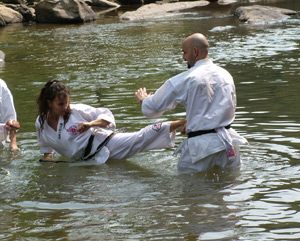 Dr. Chitose stressed the importance of small, sharp and movements. Karate is divided into three parts: Kihon (basics), Kata (forms) and Kumite (sparring). Sparring is further divided into five possible aspects of attack and
defense.
Dr. Chitose stressed the importance of small, sharp and movements. Karate is divided into three parts: Kihon (basics), Kata (forms) and Kumite (sparring). Sparring is further divided into five possible aspects of attack and
defense.
Hanshi Dometrich also stressed the importance of how you conduct yourself, right intentions, right thoughts, humility, always learning something new, and never stopping training.
Also assisting with the instruction were Renshi Steve Wilhelm who presented the Bo (staff) kata Sakugawa no Kon Sho. He stressed the organization’s recent efforts to standardize the practice of this form. Renshi Jerry
Beshears presented close fighting techniques stressing the application of elbow, knee and head strikes, as well as vulnerable anatomical points. Sensei Mark Chisenhall presented methods of training for front snap and thrust
kicks, and side snap and thrust kicks. Renshi Sherry Kembre assisted with youth training.
We were also pleased to have on hand Mr. Nick Facemire, photographer with West Virginia Sports Pics (www.wvsportspics.com) to photograph the event. He took several hundred excellent photos, which can viewed and purchased
on-line.
The seminar lasted approximately five hours and covered a wide range of philosophies and techniques. Then came the fun part, when the entire group retired to river for additional “practice”, corny karate photos in the
water and on the rocks, and general fun, games and tomfoolery. All of which was followed by a grill-out at Uncle Phil’s house, more socializing and another dip at the Messinger family swimming’ hole.

While the karate students undoubtedly enjoyed the training, it was the children of the group who had the most fun, especially with the river, campfires, burning marshmallows, and typical camping activities. The events resembled a
family reunion with the kids from the Messinger, Drummond, Khalily, Lingo, Chisenhall, Kembre and other families. Our organization now stretches to three and four generations practicing Dr. Chitose’s Karate-do.
As always the entire weekend was a very enjoyable event, and plans are already afoot for a bigger and better affair next year. Stay tuned for details.
All of us that attended want to extend our congratulations and sincerest thanks for a successful seminar to Kevin Drummond, Cyndi Drummond, Jackie Cross, Mike Messinger, Bill Messinger, David Ash, and especially Uncle Phil
Messinger who extended once again the hospitality of a true West Virginia gentleman.
For those who were unable to attend this year, please seriously consider attending next year. You won’t regret it!
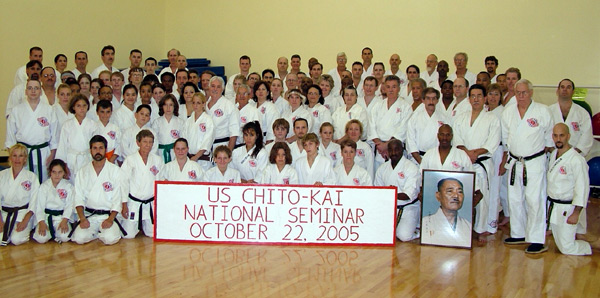
October 2005 Clinic
Cyna Khalily, MD
Yoseikan Taka no ko Dojo Louisville, KY
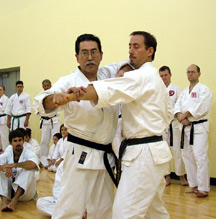 Fall is the traditional time of harvest – a gathering if you will. And so it was that on October 22, 2005 theU.S. Chito-kai and guests gathered in Northern Kentucky for the annual October seminar. And what a gathering it
was, with over 100 registered participants it was the largest October event in recent memory. This year we enjoyed a change of venue, since the facilities at NKU were so accommodating in March with the help of Sensei Willie
Elliott we were able to return for this years October clinic as well. We were honored to have Sensei David Tsuruoka as guest instructor again this year. He was so popular last year we had requested an encore, fortunately the
feeling was mutual. Here is a man who loves Karate training for the sake of training. Absolutely no ulterior motives that I can discern, no political or personal ramifications, he
Fall is the traditional time of harvest – a gathering if you will. And so it was that on October 22, 2005 theU.S. Chito-kai and guests gathered in Northern Kentucky for the annual October seminar. And what a gathering it
was, with over 100 registered participants it was the largest October event in recent memory. This year we enjoyed a change of venue, since the facilities at NKU were so accommodating in March with the help of Sensei Willie
Elliott we were able to return for this years October clinic as well. We were honored to have Sensei David Tsuruoka as guest instructor again this year. He was so popular last year we had requested an encore, fortunately the
feeling was mutual. Here is a man who loves Karate training for the sake of training. Absolutely no ulterior motives that I can discern, no political or personal ramifications, he
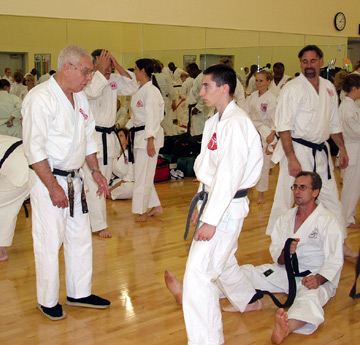 just loves to train Karate. Like father like son I suppose. To that end he paid an unsolicited, and I believe genuine, compliment to the U.S. Chito-kai saying that he was impressed that our group was by far the most advanced of
any that he had worked with. He said that our concept of “hip vibration” is unlike any other organization and most akin to his thinking. No surprise, since his lineage and ours is virtually identical; he is a student
of Masami Tsuruoka and we students of William Dometrich.
just loves to train Karate. Like father like son I suppose. To that end he paid an unsolicited, and I believe genuine, compliment to the U.S. Chito-kai saying that he was impressed that our group was by far the most advanced of
any that he had worked with. He said that our concept of “hip vibration” is unlike any other organization and most akin to his thinking. No surprise, since his lineage and ours is virtually identical; he is a student
of Masami Tsuruoka and we students of William Dometrich.
This year, after Hanshi bowed us in we divided into 4 groups by rank taught by Kysohi Hawkins, Renshi Wilhelm, Renshi Wellbrock, and Renshi Byers. We then reconvened as one large group led by Sensei Tsuruoka (he prefers to be
called Sempai, but I informed him that wasnt going to happen in the US Chito-kai). Tsuruoka Sensei then led us through a series of two-person drills that emphasized a variety of concepts ranging from hip vibration to
in-fighting to chokes. Although his instruction lasted approximately 2 hours it really felt like minutes. He does a great job of introducing universally applicable techniques and I could see that everyone from novice to senior
yudansha was able to glean something for their own development and future practice.
All in all it was a great day of training, great energy was exchanged among the participants and teachers and best of all a promise from Tsuruoka Sensei to come back again.
Great Beginning, Great End
USCK Celebrates O-Sensei’s Birthday October, 2005
Mina K. Ludwig
Yoseikan II Cincinnati, OH
On Friday October 21, the Hombu was chalk full of test candidates, Shihan-kai and several supportive yudansha. The test was efficient and power-packed. Feedback and results were provided by 9:30 pm. Karate-ka advancing to the
next belt grade include: Barbara Tarczynski, Go Dan; Mark Chisenhall, Go Dan; Mina Ludwig, Go-Dan; Kevin Drummond, Yon Dan; Wes Ernest, Yon Dan; Connie Kramer, Yon Dan; Jamie Binkley, San Dan; Ray Carrara, Jr., Ik Kyu; Emily
Gage, Ik Kyu. There will be a regional test at the Hombu in March. Please continue to heed test application requirements and deadlines so that the March test can run as smoothly as this recent national test. Congratulations to
one and all who participated. Our work and our learning are just beginning.
No rest for the weary, Saturday morning at 8:30 am the Board of Directors met for sweet rolls, coffee and to ratify the Constitution and By Laws of the USCK. Both were ratified by unanimous vote. Our Chairman, Kyoshi Hawkins, ran
a smooth and on-target meeting that addressed a number of upcoming events and programs for the USCK. Our Chief Instructor, Hanshi Dometrich, shared some positive impressions on the current and future state of the
organization.
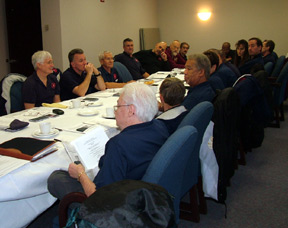 Keep your eyes open for a voluntary teaching certification program for ik-kyus and above. Our Vice-Chair, Renshi Kembre, has revamped the certification program that appears in the technical manual and will launch the course
beginning in January 2006.
Keep your eyes open for a voluntary teaching certification program for ik-kyus and above. Our Vice-Chair, Renshi Kembre, has revamped the certification program that appears in the technical manual and will launch the course
beginning in January 2006.
Getting tired of the cold already? Plan ahead for a winter hiatus in sunny Cocoa Beach, Florida! Mark your calendar and start gathering your acorns for President’s Day weekend. Look for details to follow from Sensei
Acampora.
Yours truly addressed the Board on behalf of the USCK Judiciary. We have established clear protocols to uphold the honor and dignity of the USCK. More specific information regarding these protocols will be made available soon. In
the short term, petitions or grievances may be brought to the attention of the Chairman or any member of the judiciary: Renshi Matthews, Chief Judge, Shihan Tarczynski and myself.
Otherwise, per Okusan’s request, Dojo Chief Instructors please complete and submit those monthly reports on time. Before, during and after that, get out on the deck and train (a lot). Look for opportunities to better your
technical skill and personal character and, in so doing, you will better the organization.
The banquet this year was held at a new and improved location. Sensei Elliott was good enough to secure the Ballroom of University Center at NKU. The food and the service was definitely the best yet - first class all the way,
thank you.
The keynote speaker was Renshi Wilhelm. For all the years I’ve known him, Renshi has always come into the dojo, worked out hard, spoke little and never sought attention of any sort. He doesn’t need to teach, he’s
happier training. He doesn’t need to talk, he’s happier listening. He never jockeys for position, he sits back and inwardly (I think) laughs at the people who do. As much as I admire him for all these things, it was
a rare treat to hear what he’s been thinking about lately. I always figured he thought about how easily he could kill me or others (I still think he does), but actually he’s been thinking about the relationships of
budoka and their families in history and how we are making just that sort of history today in our relationships with each other.
Giri, On and the strength of the bonds we forge over the decades is precious to us all. There’s reserved space in our hearts and minds for that even as we think of new and improved ways to elicit pain from one
another. In everything we say and do, we must be cognizant of
jita kyoe – mutual welfare and benefit.
 Hanshi and Okusan bestowed several national awards: Recognition of Longevity; Kyoshi Hawkins and Renshi Matthews, 43 years; Willie Elliot, 39 years; Renshi Wilhelm and Beshears, 38 years. Most Improved Technician, Kevin
Drummond; Sempei, Connie Kramer; Most Improved Teaching, Eric Ford; Special Efforts in National Event Planning, Willie Elliot; Special Thanks for Regional Event Coordination, Kevin Drummond, Michael Messenger, Jackie Cross,
Cindy Drummond and Kim Flossie. A very special award went to Hanshi’s sempai, and sempai to us all, Hanshi Tsuruoka who was unable to join us but is rapidly getting back to good health and butt-kicking spirit. Three bonzai
were raised by the masses in his honor and also in honor of O-Sensei’s birthday. Also a very special award was given to our honored guest instructor, Shihan David Tsuruoka who gifted us with his inspiring clarity of
spirit, intent and communication. His love for karate and filial piety are abundantly evident and truly admirable. Thank you again, Sensei, from the USCK.
Hanshi and Okusan bestowed several national awards: Recognition of Longevity; Kyoshi Hawkins and Renshi Matthews, 43 years; Willie Elliot, 39 years; Renshi Wilhelm and Beshears, 38 years. Most Improved Technician, Kevin
Drummond; Sempei, Connie Kramer; Most Improved Teaching, Eric Ford; Special Efforts in National Event Planning, Willie Elliot; Special Thanks for Regional Event Coordination, Kevin Drummond, Michael Messenger, Jackie Cross,
Cindy Drummond and Kim Flossie. A very special award went to Hanshi’s sempai, and sempai to us all, Hanshi Tsuruoka who was unable to join us but is rapidly getting back to good health and butt-kicking spirit. Three bonzai
were raised by the masses in his honor and also in honor of O-Sensei’s birthday. Also a very special award was given to our honored guest instructor, Shihan David Tsuruoka who gifted us with his inspiring clarity of
spirit, intent and communication. His love for karate and filial piety are abundantly evident and truly admirable. Thank you again, Sensei, from the USCK.
Awards of rank and/or title ratified by the Shihan kai and bestowed by Hanshi and Okusan include: James Matthews, Renshi/Roku Dan; and, Mina K. Ludwig, Shihan. My husband extends his bemused thanks to Hanshi, Okusan and the
Shihan-kai for effectively rendering me speechless.
Then there was the after-party. Kyoshi Hawkins hospitality suite was most hospitable and downright hopping. It seems most of the USCK was in and around there until the wee hours. I felt like I was back in my old college dorm.
Party in the room, in the hall, in the room next door – everywhere you looked, the Federation was at play. If you didn’t make it this year, now you know where to go next year.
In keeping with Renshi Wilhelm’s theme, a few parting lines about loyalty, selflessness and communal strength:
“A wall standing alone is useless, but put three or four walls together, and they’ll support a roof and keep the grain dry and safe. When ink joins with a pen, then the blank paper can say something. Rushes and
reeds must be woven to be useful as a mat. If they weren’t interlaced, the wind would blow them away.” – Rumi
I look forward to the opportunity to come together and train, play and make a little history with you all again soon.
 January 25th the 22nd annual Kangeiko was held at the Yoseikan Hombu dojo in Covington, Ky. The training was lead by Renshi James Davenport and assisted by Manuel Byers, Hanshi Dometrich came on his crutches at 6 am to observe some
of the intense training. After breakfast many students stayed on for the regular Saturday class and then in the afternoon attended Black Belt Class. It was a full weekend for many who had traveled from Pennsylvania, Indiana, New
York, Florida, Kentucky and Ohio.
January 25th the 22nd annual Kangeiko was held at the Yoseikan Hombu dojo in Covington, Ky. The training was lead by Renshi James Davenport and assisted by Manuel Byers, Hanshi Dometrich came on his crutches at 6 am to observe some
of the intense training. After breakfast many students stayed on for the regular Saturday class and then in the afternoon attended Black Belt Class. It was a full weekend for many who had traveled from Pennsylvania, Indiana, New
York, Florida, Kentucky and Ohio.

 April 11/12/13 thirteen members of the United States Chito-kai had purchased airline tickets to attend the Ozawa Memorial Karate championships. The tickets had already been bought when we found out that the Tournament had been
canceled, so our group went anyway and made a mini vacation out of it. We got to see Las Vegas since we hadn't before because all our time had always been spent at the tournament and seminars. Some of us went to Boulder Dam and Red
Rock Canyon. Hanshi and Okusan along with Renshi Davenport and his wife Laura drove to San Bernardino Calif. to visit with Yukinori Kugimiya and his mother.
April 11/12/13 thirteen members of the United States Chito-kai had purchased airline tickets to attend the Ozawa Memorial Karate championships. The tickets had already been bought when we found out that the Tournament had been
canceled, so our group went anyway and made a mini vacation out of it. We got to see Las Vegas since we hadn't before because all our time had always been spent at the tournament and seminars. Some of us went to Boulder Dam and Red
Rock Canyon. Hanshi and Okusan along with Renshi Davenport and his wife Laura drove to San Bernardino Calif. to visit with Yukinori Kugimiya and his mother.
 June 12-14,2001 the Police and Fire games were held in Indianapolis Indiana, Sensei Fumio Demura was the chief referee for the karate events. He asked Hanshi Dometrich to assist him. Hanshi's roommate was long time friend Bill
Wallace. Renshi Beshears came to assist with the matches. Not only did they have Martial Arts they had every kind of sport imaginable. The International Police and Fire games are held every three years, the next one will be held in
Barcelona Spain, 2003.
June 12-14,2001 the Police and Fire games were held in Indianapolis Indiana, Sensei Fumio Demura was the chief referee for the karate events. He asked Hanshi Dometrich to assist him. Hanshi's roommate was long time friend Bill
Wallace. Renshi Beshears came to assist with the matches. Not only did they have Martial Arts they had every kind of sport imaginable. The International Police and Fire games are held every three years, the next one will be held in
Barcelona Spain, 2003.


 June 26-30, 2001 the AAU (Amateur Athletic Union) held their National Karate Championships in Kenner, Louisiana. A small but dedicated group of karate-ka from the Yoseikan Hombu, who had first qualified at the
Kentucky AAU Tournament then at the region 6 Tournament in Chicago, made the trip. While there were only six students competing, they represented Chito-ryu and the Yoseikan Karate school exceptionally well. All six medalled and
qualified as AAU Champions.
June 26-30, 2001 the AAU (Amateur Athletic Union) held their National Karate Championships in Kenner, Louisiana. A small but dedicated group of karate-ka from the Yoseikan Hombu, who had first qualified at the
Kentucky AAU Tournament then at the region 6 Tournament in Chicago, made the trip. While there were only six students competing, they represented Chito-ryu and the Yoseikan Karate school exceptionally well. All six medalled and
qualified as AAU Champions.
 July 21,2001, Shochugeiko was held at Big Bone State Park. Students from all across the country attended. Senior ranking instructors of the U.S Chito-kai led group sessions. The event ended with a cookout.
July 21,2001, Shochugeiko was held at Big Bone State Park. Students from all across the country attended. Senior ranking instructors of the U.S Chito-kai led group sessions. The event ended with a cookout.


 The United States Chito-Kai would like to welcome Sensei Richey Brock from Birmingham Alabama into the United States Chito-Kai family. Sensei Brock has been a member of the Yoshukai organization, which is an offshoot
of Dr. Chitose's Chito-ryu.
The United States Chito-Kai would like to welcome Sensei Richey Brock from Birmingham Alabama into the United States Chito-Kai family. Sensei Brock has been a member of the Yoshukai organization, which is an offshoot
of Dr. Chitose's Chito-ryu.



 Banquet. This year was very special because we were celebrating Hanshi William Dometrich’s 50 years in Martial Arts. There
were 190 Instructors and students attending the seminars. Guest Instructors were Sensei David Akutagawa from Canada, Yukinori Kugimiya from California and Ken Sakamoto from Kumamoto, Japan. 254 members, friends and spouses attend
the Banquet. Many gifts, speeches and letters of respectful admiration were read. The whole weekend was very memorable for our Chito-ryu family. The highlight of the whole affair was when Hanshi was presented with the first
copy of his book "The Endless Quest" which he had been working on writing for two decades. Chris Johnston from Mississauga, Canada, who operates "Shindokan Publishers" and Okusan collaborated and led Hanshi to
believe that the book was going to be published in March 2002. Hanshi was really caught off guard when the book was presented to him. The book is now in its second printing.
Banquet. This year was very special because we were celebrating Hanshi William Dometrich’s 50 years in Martial Arts. There
were 190 Instructors and students attending the seminars. Guest Instructors were Sensei David Akutagawa from Canada, Yukinori Kugimiya from California and Ken Sakamoto from Kumamoto, Japan. 254 members, friends and spouses attend
the Banquet. Many gifts, speeches and letters of respectful admiration were read. The whole weekend was very memorable for our Chito-ryu family. The highlight of the whole affair was when Hanshi was presented with the first
copy of his book "The Endless Quest" which he had been working on writing for two decades. Chris Johnston from Mississauga, Canada, who operates "Shindokan Publishers" and Okusan collaborated and led Hanshi to
believe that the book was going to be published in March 2002. Hanshi was really caught off guard when the book was presented to him. The book is now in its second printing.

 November 13,2001 The Mayor of Covington, Ky, Butch Callery, and the board of commissioners, commended William J. Dometrich on his 50 years of Martial Arts training and 22 years as a Police Officer in the city of
Covington Ky. (Hanshi retired at the rank of Lieutenant Colonel and the Assistant Chief of Police, in 1986.) Mayor Callery presented Hanshi Dometrich with the Key to the city. Two students of Hanshi Dometrich, Tom Schonecker and
James Liles were encouraged by Hanshi Dometrich to become Police Officers, these two men are now: Chief of Police (Tom Schonecker) and Assistant Chief of Police (James Liles) both men held Black Belts in Chito- Ryu.
November 13,2001 The Mayor of Covington, Ky, Butch Callery, and the board of commissioners, commended William J. Dometrich on his 50 years of Martial Arts training and 22 years as a Police Officer in the city of
Covington Ky. (Hanshi retired at the rank of Lieutenant Colonel and the Assistant Chief of Police, in 1986.) Mayor Callery presented Hanshi Dometrich with the Key to the city. Two students of Hanshi Dometrich, Tom Schonecker and
James Liles were encouraged by Hanshi Dometrich to become Police Officers, these two men are now: Chief of Police (Tom Schonecker) and Assistant Chief of Police (James Liles) both men held Black Belts in Chito- Ryu.















 Kangeiko 2003 was held January 24-25 at the US Chito-kai Hombu Dojo. Kangeiko is traditional cold weather martial training that is held during the coldest part of winter. This year’s event was well planned
as we had record cold temperatures in the Midwest the whole week as well as some light snow – perfect Kangeiko weather! In Japan, Kangeiko is usually help on a daily basis for an hour or two for anywhere from a week to a month.
The tradition in the US Chito-kai is a one day 6 hour session of intense “Spirit training”. This year marked the 24th consecutive year for Kangeiko at the Yoseikan Hombu. Following in tradition, the event begins the night
before, when all participants and instructors gather at the Hombu Dojo. An excellent pre-training meal of pasta and salad (also known to some as “the last supper”) was prepared by Okusan and Kathy Webster. Participants
sleep on the Dojo floor and although the forecast was for temperatures around zero overnight, there is no heat during Kangeiko. Prior to lights-out a pep talk was delivered by Kyoshi VanHorne and Kyoshi Davenport. Kyoshi Davenport
served as principal instructor for the event and has participated in 23 Kangeiko, most of which he has led. In attendance were 28 karate-ka from the Hombu, West Virginia, Pittsburgh, Frankfort, and Cincinnati. But the prize for
longest distance traveled for the event goes (once again) to Laurie Apchin from Provence, France (can anyone say “Road trip”?). Kyoshi Davenport was assisted by Kyoshi VanHorne and Renshi Valentino. Students ranged in rank
from green III (the minimum requirement) to Yon Dan, from 17 to 52 years old and from first timers to Sensei William Jansak from the Yoseikan II Cincinnati, a veteran of 20 consecutive Kangeiko.
Kangeiko 2003 was held January 24-25 at the US Chito-kai Hombu Dojo. Kangeiko is traditional cold weather martial training that is held during the coldest part of winter. This year’s event was well planned
as we had record cold temperatures in the Midwest the whole week as well as some light snow – perfect Kangeiko weather! In Japan, Kangeiko is usually help on a daily basis for an hour or two for anywhere from a week to a month.
The tradition in the US Chito-kai is a one day 6 hour session of intense “Spirit training”. This year marked the 24th consecutive year for Kangeiko at the Yoseikan Hombu. Following in tradition, the event begins the night
before, when all participants and instructors gather at the Hombu Dojo. An excellent pre-training meal of pasta and salad (also known to some as “the last supper”) was prepared by Okusan and Kathy Webster. Participants
sleep on the Dojo floor and although the forecast was for temperatures around zero overnight, there is no heat during Kangeiko. Prior to lights-out a pep talk was delivered by Kyoshi VanHorne and Kyoshi Davenport. Kyoshi Davenport
served as principal instructor for the event and has participated in 23 Kangeiko, most of which he has led. In attendance were 28 karate-ka from the Hombu, West Virginia, Pittsburgh, Frankfort, and Cincinnati. But the prize for
longest distance traveled for the event goes (once again) to Laurie Apchin from Provence, France (can anyone say “Road trip”?). Kyoshi Davenport was assisted by Kyoshi VanHorne and Renshi Valentino. Students ranged in rank
from green III (the minimum requirement) to Yon Dan, from 17 to 52 years old and from first timers to Sensei William Jansak from the Yoseikan II Cincinnati, a veteran of 20 consecutive Kangeiko.

 On Thursday morning, Hanshi, Okusan and others gave an interview and Karate demonstration for the local news, which aired on WBOY channel 12 on Monday March 17. Thursday evening Hanshi and Okusan attended class
at the Bridgeport Yoseikan. Also visiting were Renshi Jerry Wellbrock, Renshi Michael Colling, Shihan Cyna Khalily and Sensei Mina Ludwig. Linda Gage also came with a crew of kids from her school in Charlotte, VA. Hanshi Dometrich
led the class in Chito-ryu basics. For some of the students this was their first exposure to true “Chito-ryu” technique. But what an introduction – from Hanshi Dometrich himself! It was a great class.
On Thursday morning, Hanshi, Okusan and others gave an interview and Karate demonstration for the local news, which aired on WBOY channel 12 on Monday March 17. Thursday evening Hanshi and Okusan attended class
at the Bridgeport Yoseikan. Also visiting were Renshi Jerry Wellbrock, Renshi Michael Colling, Shihan Cyna Khalily and Sensei Mina Ludwig. Linda Gage also came with a crew of kids from her school in Charlotte, VA. Hanshi Dometrich
led the class in Chito-ryu basics. For some of the students this was their first exposure to true “Chito-ryu” technique. But what an introduction – from Hanshi Dometrich himself! It was a great class.








 relation to their applications. That way the kata is learned in a context of individual technique applications. This did prove to be an effective teaching method, and even though many of the attendees may not
remember Wanchin kata exactly, they will at least have gained an understanding of the rational for some of the techniques contained therein. Kyoshi Smiths profound understanding of Karate history as well as his technical expertise
was evident during the coursed of the seminar. In addition to Wanchin kata, Kyoshi Smith also shared some insight into the meaning and application of “ippon kumite”. Three hours went by all to quickly. In the end, we found
that Seibukan Shorin-ryu and Chito-ryu are more similar than they are different. And we all agreed that continued brotherhood and exchange will make us all stronger. There were over 90 participants at the clinic from all around the
United States. This gym has a lot of history for the US Chito-kai – O-Sensei once taught a seminar there and many current members had their early lessons there. Thank-you to Dr. Willie Elliot for securing the venue and carrying
on the NKU Chito-ryu tradition.
relation to their applications. That way the kata is learned in a context of individual technique applications. This did prove to be an effective teaching method, and even though many of the attendees may not
remember Wanchin kata exactly, they will at least have gained an understanding of the rational for some of the techniques contained therein. Kyoshi Smiths profound understanding of Karate history as well as his technical expertise
was evident during the coursed of the seminar. In addition to Wanchin kata, Kyoshi Smith also shared some insight into the meaning and application of “ippon kumite”. Three hours went by all to quickly. In the end, we found
that Seibukan Shorin-ryu and Chito-ryu are more similar than they are different. And we all agreed that continued brotherhood and exchange will make us all stronger. There were over 90 participants at the clinic from all around the
United States. This gym has a lot of history for the US Chito-kai – O-Sensei once taught a seminar there and many current members had their early lessons there. Thank-you to Dr. Willie Elliot for securing the venue and carrying
on the NKU Chito-ryu tradition.















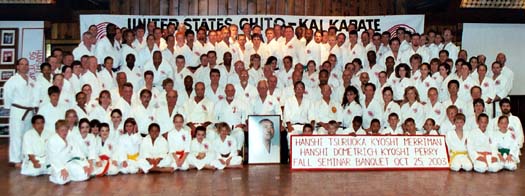




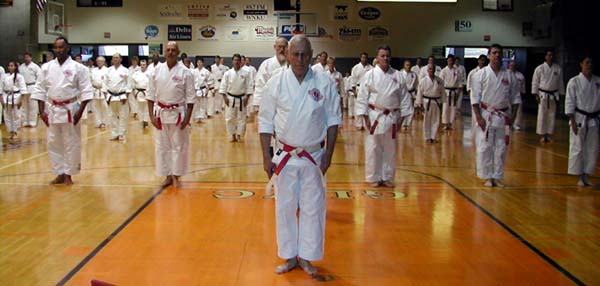
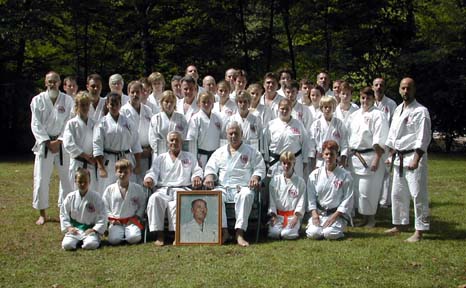
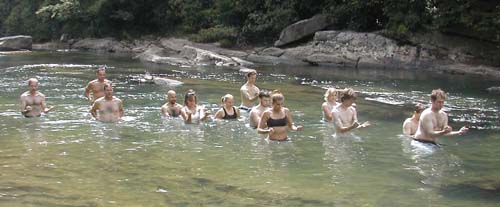

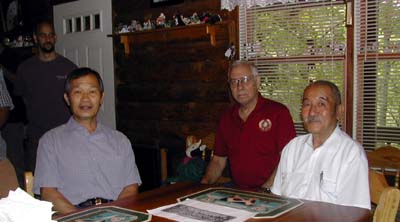 Afterwards, Okusan, Sensei Herbst, and Kathy Webster had a post-training meal prepared for us that was unexpected but certainly well received. Hanshi Dometrich and Inamoto Sensei then sat down for
a long in-depth discussion regarding the past, present, and future state of Chito-ryu and Karate-do (this time with much better translators).
Afterwards, Okusan, Sensei Herbst, and Kathy Webster had a post-training meal prepared for us that was unexpected but certainly well received. Hanshi Dometrich and Inamoto Sensei then sat down for
a long in-depth discussion regarding the past, present, and future state of Chito-ryu and Karate-do (this time with much better translators).
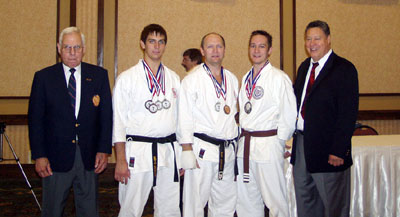
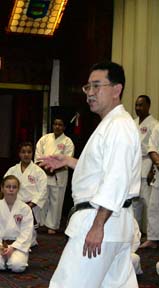 The clinic started soon after the test. In addition to Hanshi Dometrich, this years special guest instructor was Sensei David Tsuruoka. Tsuruoka Sensei is the son of our good friend Hanshi Masami
Tsuruoka. Unfortunately, Hanshi Tsuruoka has not been feeling well recently so he sent his son to fulfill his obligation. And what a substitute! Although Hanshi Dometrich has known David Tsuruoka Sensei since he was around 9
years old, he has never visited or taught a class for the U.S. Chito-kai. It was obvious in his teaching that Tsuruoka Sensei has a passion for what he does. He went over a lot of universally applicable concepts that
emphasized economic and efficient mechanics and speed. His teaching was clear and organized and very well received by the clinic participants.
The clinic started soon after the test. In addition to Hanshi Dometrich, this years special guest instructor was Sensei David Tsuruoka. Tsuruoka Sensei is the son of our good friend Hanshi Masami
Tsuruoka. Unfortunately, Hanshi Tsuruoka has not been feeling well recently so he sent his son to fulfill his obligation. And what a substitute! Although Hanshi Dometrich has known David Tsuruoka Sensei since he was around 9
years old, he has never visited or taught a class for the U.S. Chito-kai. It was obvious in his teaching that Tsuruoka Sensei has a passion for what he does. He went over a lot of universally applicable concepts that
emphasized economic and efficient mechanics and speed. His teaching was clear and organized and very well received by the clinic participants.
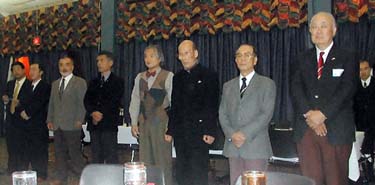
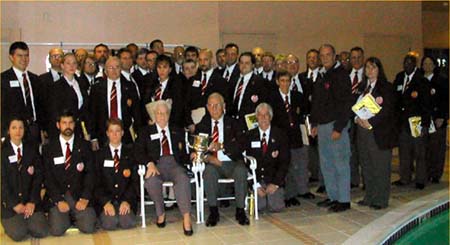
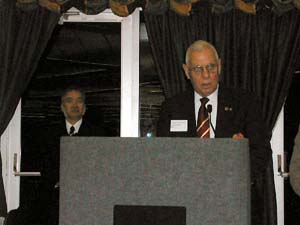
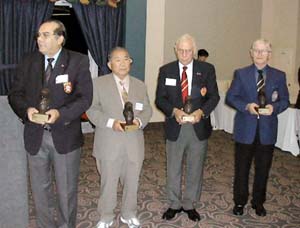


















 For the third hour and a half, there was a changing of the guards. Black and Brown belts worked Sakugawa no kon sho. We can look forward to the manual which Renshi Wilhelm and Sensei Ford have been diligently working on. The
green belts worked on Niseishi kata and kai setz with Shihan Khalily. The white, yellow and orange belts worked on moving from the center, strengthening the tanden and theories of kazushi with Renshei Beshears.
For the third hour and a half, there was a changing of the guards. Black and Brown belts worked Sakugawa no kon sho. We can look forward to the manual which Renshi Wilhelm and Sensei Ford have been diligently working on. The
green belts worked on Niseishi kata and kai setz with Shihan Khalily. The white, yellow and orange belts worked on moving from the center, strengthening the tanden and theories of kazushi with Renshei Beshears.

 The event was attended by approximately thirty-five karate students of all ages and experience levels, and led by Hanshi Dometrich. Most of us arrived throughout Thursday and Friday, allowing us to take advantage of the park’s
facilities and to do some socializing with our Karate brethren before the seminar on Saturday morning. We were pleased to see folks from Hombu, Louisville, Cincinnati and Fort Bragg Dojos. The latter included Mr. Ricky Glass and
Mr. Richard Partida, both currently on active duty with the United States Army, and students at one of our newest affiliated dojo headed by Sensei “Po” Pochinsky. On Friday evening a traditional West Virginia style
Italian dinner was hosted by Cindy Drummond and Jackie Cross, and held at Uncle Phil Messinger’s house, across the river from the park.
The event was attended by approximately thirty-five karate students of all ages and experience levels, and led by Hanshi Dometrich. Most of us arrived throughout Thursday and Friday, allowing us to take advantage of the park’s
facilities and to do some socializing with our Karate brethren before the seminar on Saturday morning. We were pleased to see folks from Hombu, Louisville, Cincinnati and Fort Bragg Dojos. The latter included Mr. Ricky Glass and
Mr. Richard Partida, both currently on active duty with the United States Army, and students at one of our newest affiliated dojo headed by Sensei “Po” Pochinsky. On Friday evening a traditional West Virginia style
Italian dinner was hosted by Cindy Drummond and Jackie Cross, and held at Uncle Phil Messinger’s house, across the river from the park.
 Dr. Chitose stressed the importance of small, sharp and movements. Karate is divided into three parts: Kihon (basics), Kata (forms) and Kumite (sparring). Sparring is further divided into five possible aspects of attack and
defense.
Dr. Chitose stressed the importance of small, sharp and movements. Karate is divided into three parts: Kihon (basics), Kata (forms) and Kumite (sparring). Sparring is further divided into five possible aspects of attack and
defense.


 Fall is the traditional time of harvest – a gathering if you will. And so it was that on October 22, 2005 theU.S. Chito-kai and guests gathered in Northern Kentucky for the annual October seminar. And what a gathering it
was, with over 100 registered participants it was the largest October event in recent memory. This year we enjoyed a change of venue, since the facilities at NKU were so accommodating in March with the help of Sensei Willie
Elliott we were able to return for this years October clinic as well. We were honored to have Sensei David Tsuruoka as guest instructor again this year. He was so popular last year we had requested an encore, fortunately the
feeling was mutual. Here is a man who loves Karate training for the sake of training. Absolutely no ulterior motives that I can discern, no political or personal ramifications, he
Fall is the traditional time of harvest – a gathering if you will. And so it was that on October 22, 2005 theU.S. Chito-kai and guests gathered in Northern Kentucky for the annual October seminar. And what a gathering it
was, with over 100 registered participants it was the largest October event in recent memory. This year we enjoyed a change of venue, since the facilities at NKU were so accommodating in March with the help of Sensei Willie
Elliott we were able to return for this years October clinic as well. We were honored to have Sensei David Tsuruoka as guest instructor again this year. He was so popular last year we had requested an encore, fortunately the
feeling was mutual. Here is a man who loves Karate training for the sake of training. Absolutely no ulterior motives that I can discern, no political or personal ramifications, he
 just loves to train Karate. Like father like son I suppose. To that end he paid an unsolicited, and I believe genuine, compliment to the U.S. Chito-kai saying that he was impressed that our group was by far the most advanced of
any that he had worked with. He said that our concept of “hip vibration” is unlike any other organization and most akin to his thinking. No surprise, since his lineage and ours is virtually identical; he is a student
of Masami Tsuruoka and we students of William Dometrich.
just loves to train Karate. Like father like son I suppose. To that end he paid an unsolicited, and I believe genuine, compliment to the U.S. Chito-kai saying that he was impressed that our group was by far the most advanced of
any that he had worked with. He said that our concept of “hip vibration” is unlike any other organization and most akin to his thinking. No surprise, since his lineage and ours is virtually identical; he is a student
of Masami Tsuruoka and we students of William Dometrich.
 Keep your eyes open for a voluntary teaching certification program for ik-kyus and above. Our Vice-Chair, Renshi Kembre, has revamped the certification program that appears in the technical manual and will launch the course
beginning in January 2006.
Keep your eyes open for a voluntary teaching certification program for ik-kyus and above. Our Vice-Chair, Renshi Kembre, has revamped the certification program that appears in the technical manual and will launch the course
beginning in January 2006.
 Hanshi and Okusan bestowed several national awards: Recognition of Longevity; Kyoshi Hawkins and Renshi Matthews, 43 years; Willie Elliot, 39 years; Renshi Wilhelm and Beshears, 38 years. Most Improved Technician, Kevin
Drummond; Sempei, Connie Kramer; Most Improved Teaching, Eric Ford; Special Efforts in National Event Planning, Willie Elliot; Special Thanks for Regional Event Coordination, Kevin Drummond, Michael Messenger, Jackie Cross,
Cindy Drummond and Kim Flossie. A very special award went to Hanshi’s sempai, and sempai to us all, Hanshi Tsuruoka who was unable to join us but is rapidly getting back to good health and butt-kicking spirit. Three bonzai
were raised by the masses in his honor and also in honor of O-Sensei’s birthday. Also a very special award was given to our honored guest instructor, Shihan David Tsuruoka who gifted us with his inspiring clarity of
spirit, intent and communication. His love for karate and filial piety are abundantly evident and truly admirable. Thank you again, Sensei, from the USCK.
Hanshi and Okusan bestowed several national awards: Recognition of Longevity; Kyoshi Hawkins and Renshi Matthews, 43 years; Willie Elliot, 39 years; Renshi Wilhelm and Beshears, 38 years. Most Improved Technician, Kevin
Drummond; Sempei, Connie Kramer; Most Improved Teaching, Eric Ford; Special Efforts in National Event Planning, Willie Elliot; Special Thanks for Regional Event Coordination, Kevin Drummond, Michael Messenger, Jackie Cross,
Cindy Drummond and Kim Flossie. A very special award went to Hanshi’s sempai, and sempai to us all, Hanshi Tsuruoka who was unable to join us but is rapidly getting back to good health and butt-kicking spirit. Three bonzai
were raised by the masses in his honor and also in honor of O-Sensei’s birthday. Also a very special award was given to our honored guest instructor, Shihan David Tsuruoka who gifted us with his inspiring clarity of
spirit, intent and communication. His love for karate and filial piety are abundantly evident and truly admirable. Thank you again, Sensei, from the USCK.